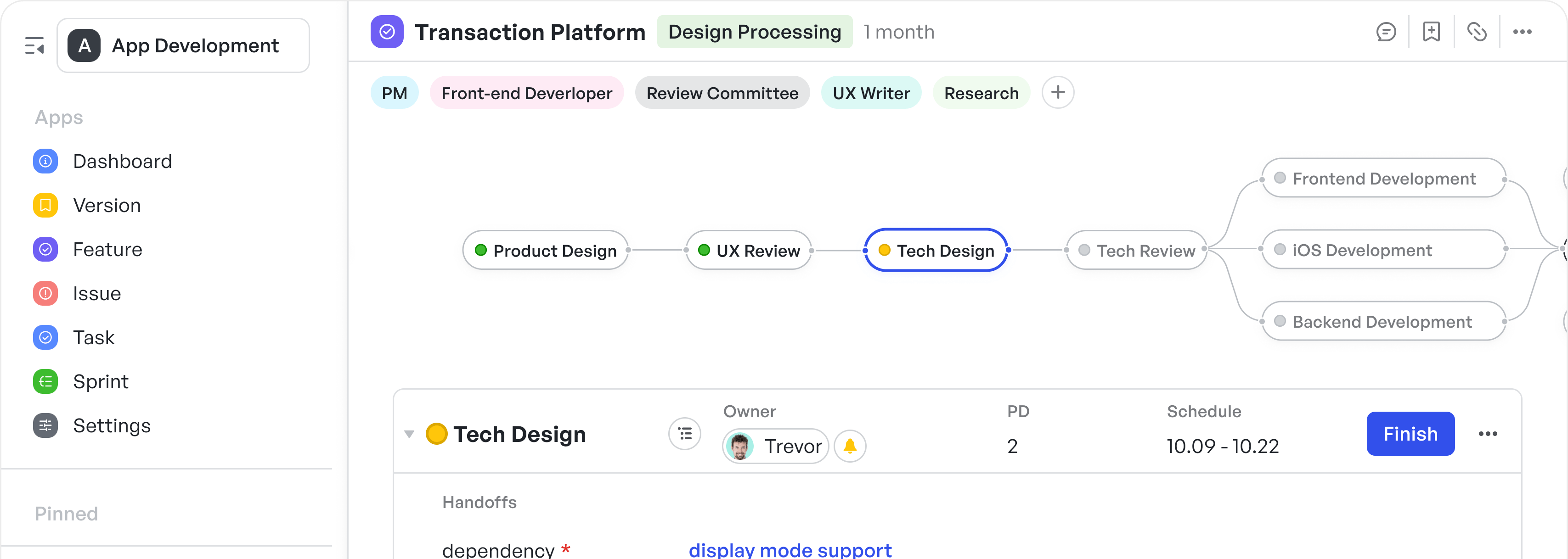What is Product Portfolio Management: Frameworks, Templates, and Tools

You're mid-project when the sprint board reveals a surprise feature no one remembers green-lighting. Half the team is already tied up with the mobile redesign, and the data science team is booked on another task.
For product managers, this kind of resource scramble is all too familiar. Despite careful planning, they often discover too late that teams are stretched thin—or worse, working on overlapping priorities. The problem usually comes down to two things: limited resources and not enough visibility. Without a clear, real-time view of team capacity and project status, it's hard to stay on track or make confident decisions.
What can save you here is product portfolio management (PPM), a practice embraced by product leaders, PMOs, and Chief Product Officers (CPOs) to balance resources, align products with market needs, and maximize the portfolio’s value.
In this guide, we’ll explain what PPM is, why it’s important, and how it can help you manage resources better, avoid last-minute surprises, and make sure your team’s effort is not wasted on low-impact tasks.
What is product portfolio management?
Product Portfolio Management (PPM) is the process of overseeing all the products a company offers, and making sure they support business goals, deliver value, and use resources wisely. It includes:
- Reviewing product performance at each stage of the lifecycle
- Choosing where to invest based on potential, risk, and fit
- Balancing short-term gains and long-term growth
- Deciding which products to launch, improve, or retire
It also entails that product managers ensure cross-functional coordination, so product, design, engineering, and business teams act on shared priorities and timelines.
Importance and benefits of PPM
Product portfolio management delivers tangible improvements across multiple areas by transforming scattered product decisions into coordinated efforts that drive business results.
- Enhanced ROI and resource efficiency: Companies with mature portfolio management practices achieve 27% higher performance than those using ad hoc methods. By centralizing resource allocation and implementing scheduling, organizations eliminate duplicate efforts and redirect talent toward high-impact initiatives that differentiate in the market.
- Improved market responsiveness: Research shows 72% of organizations struggle to adjust their project portfolios quickly enough to keep pace with market changes. Effective portfolio management reduces realignment time from months to weeks, enabling teams to capitalize on market opportunities and avoid missing critical launch windows.
- Better cross-functional alignment: PPM involves creating transparent decision-making frameworks that align sales, marketing, and product teams on prioritization criteria. This reduces friction between departments and creates unified go-to-market approaches that maximize promotional impact.
- Risk reduction and portfolio balance: Systematic portfolio oversight helps organizations identify gaps, redundancies, and over-concentration in specific market segments. This visibility enables proactive adjustments that maintain healthy portfolio balance while minimizing exposure to market volatility.
- Accelerated decision-making: Standardized evaluation processes and clear metrics eliminate lengthy debates about resource allocation. Teams can quickly assess opportunities against established criteria, speeding up product launches and feature releases.
These benefits compound over time, creating organizations that respond faster to market changes, waste fewer resources on low-impact initiatives, and consistently deliver products that align with business objectives.
Product portfolio management vs. project portfolio management
One should not confuse product portfolio management with project portfolio management.
While product portfolio management oversees your entire suite of ongoing product offerings, project portfolio management handles temporary initiatives with defined start and end dates, such as a website redesign or compliance implementation. It focuses on execution timelines, resource allocation, and deliverable quality.
Where they intersect is in resource allocation and prioritization frameworks. Both disciplines require systematic approaches to determine where to invest limited time and budget.
Product vs. project portfolio management: a comparison
| Aspect | Product Portfolio Management | Project Portfolio Management |
|---|---|---|
| Timeframe | Ongoing and continuous | Temporary with defined start/end dates |
| Focus | Market fit and product performance | Delivery timelines and scope adherence |
| Leadership | Product managers with strategic authority | Project managers with tactical execution focus |
| Team structure | Persistent teams organized around product lines | Temporary cross-functional teams formed for specific initiatives |
| Success metrics | Revenue, market share, customer retention | On-time delivery, budget adherence, scope completion |
| Decision framework | Which products to invest in, maintain, or retire | Which projects to prioritize, delay, or cancel |
Product portfolio management frameworks that actually work
Product portfolio management thrives on structured frameworks that guide strategic decisions. These models help product managers evaluate products, prioritize investments, and maintain portfolio health.
TL;DR
To manage product portfolios effectively, PMs rely on proven frameworks that balance strategy, resources, and timing.
- BCG growth-share matrix: Classifies products as Stars, Cash Cows, Question Marks, or Dogs to guide where to invest or divest. Best for: Quick, high-level portfolio decisions.
- GE-McKinsey nine-box matrix: Evaluates products by business strength and market attractiveness for more nuanced decisions. Best for: Complex, diversified portfolios.
- RICE & Impact-effort matrices: Score and visualize initiatives based on value vs. effort. Best for: Fast-paced industries needing clear prioritization.
- Product lifecycle management (PLM): Maps products from launch to retirement to manage investments over time. Best for: Keeping the portfolio lean and current.
1. Portfolio evaluation frameworks
Evaluation frameworks provide a high-level view of your portfolio’s performance and potential.
1.1 BCG growth-share matrix
The BCG growth-share matrix categorizes products by market growth and relative market share into four types:
- Stars (high growth, high share): Products with high potential that require investment
- Cash Cows (low growth, high share): Stable revenue generators with minimal investment needs
- Question Marks (high growth, low share): Products with potential but unproven market position
- Dogs (low growth, low share): Underperforming products that may require divestment
This model helps decide which products to invest in, maintain, harvest, or divest.
Best for: Quickly assessing portfolio balance, ensuring resources support both growth and profitability.
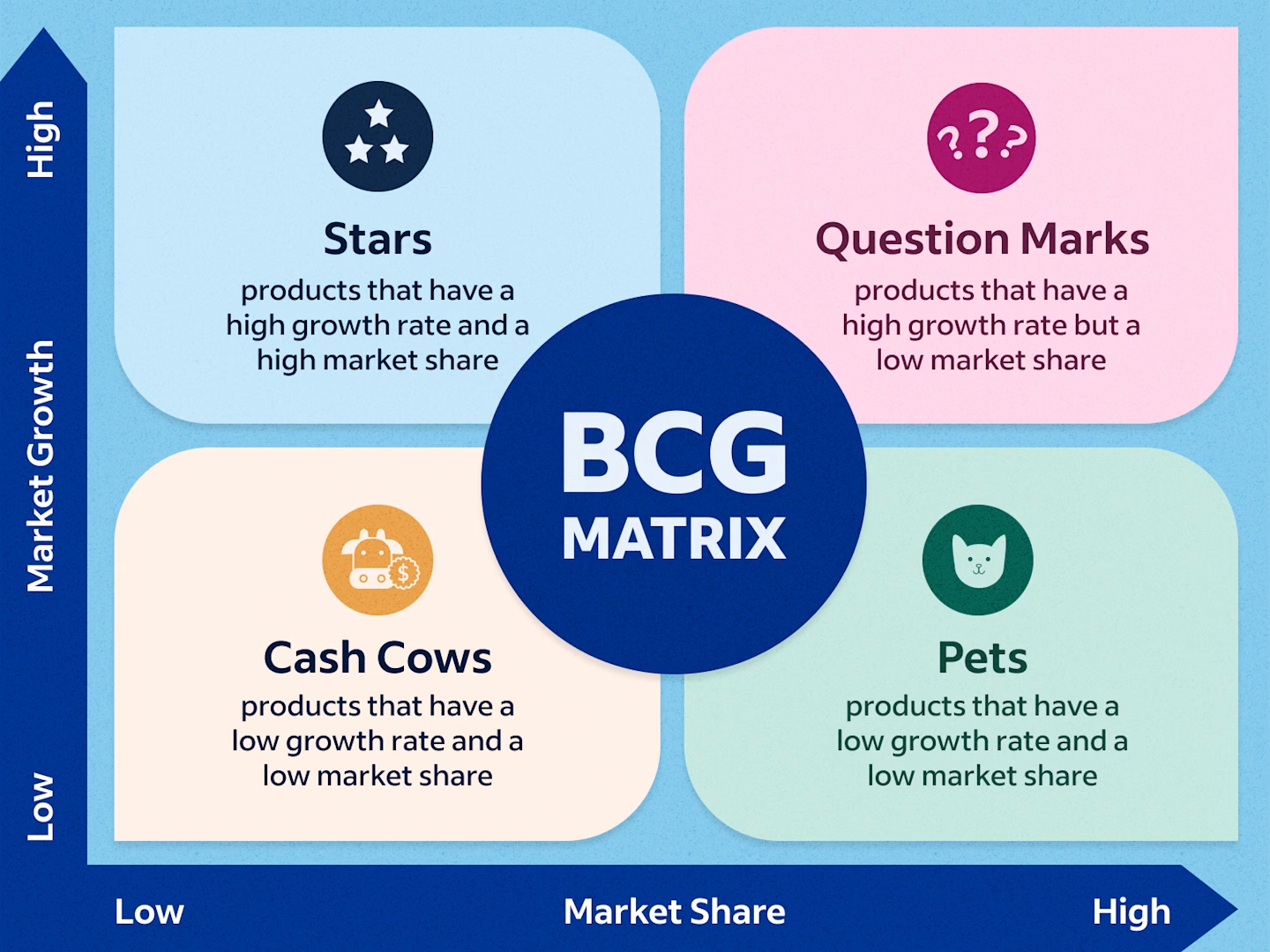 BCG growth-share matrix showing Stars, Question Marks, Cash Cows, and Pets based on market growth and share. (Source: Indeed)
BCG growth-share matrix showing Stars, Question Marks, Cash Cows, and Pets based on market growth and share. (Source: Indeed)1.2 GE-McKinsey nine-box matrix
The GE-McKinsey nine-box matrix evaluates products based on industry attractiveness (e.g., market size, growth rate) and business strength (e.g., brand, distribution). It is a sophisticated alternative to the BCG Matrix. It supports nuanced decisions for complex portfolios with multiple market variables, guiding investment decisions.
Best for: Mature companies or diversified portfolios needing multi-factor analysis.
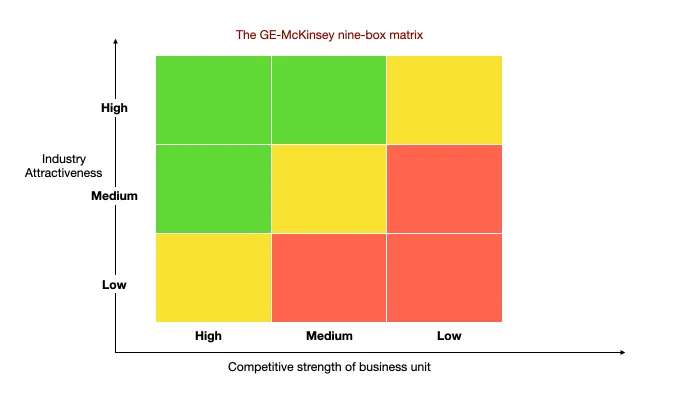 GE-McKinsey nine-box matrix evaluating business units by industry attractiveness and competitive strength. (Source: Product Mindset)
GE-McKinsey nine-box matrix evaluating business units by industry attractiveness and competitive strength. (Source: Product Mindset)2. Prioritization frameworks: choosing where to invest
Prioritization frameworks help allocate resources to high-impact initiatives in dynamic environments such as markets with shifting conditions, evolving customer needs, or frequent competitive changes.
Frameworks like RICE (Reach, Impact, Confidence, Effort) rank product initiatives by quantifying potential benefits against effort. For example, a feature reaching 10,000 users with high impact scores ranks higher than a niche update.
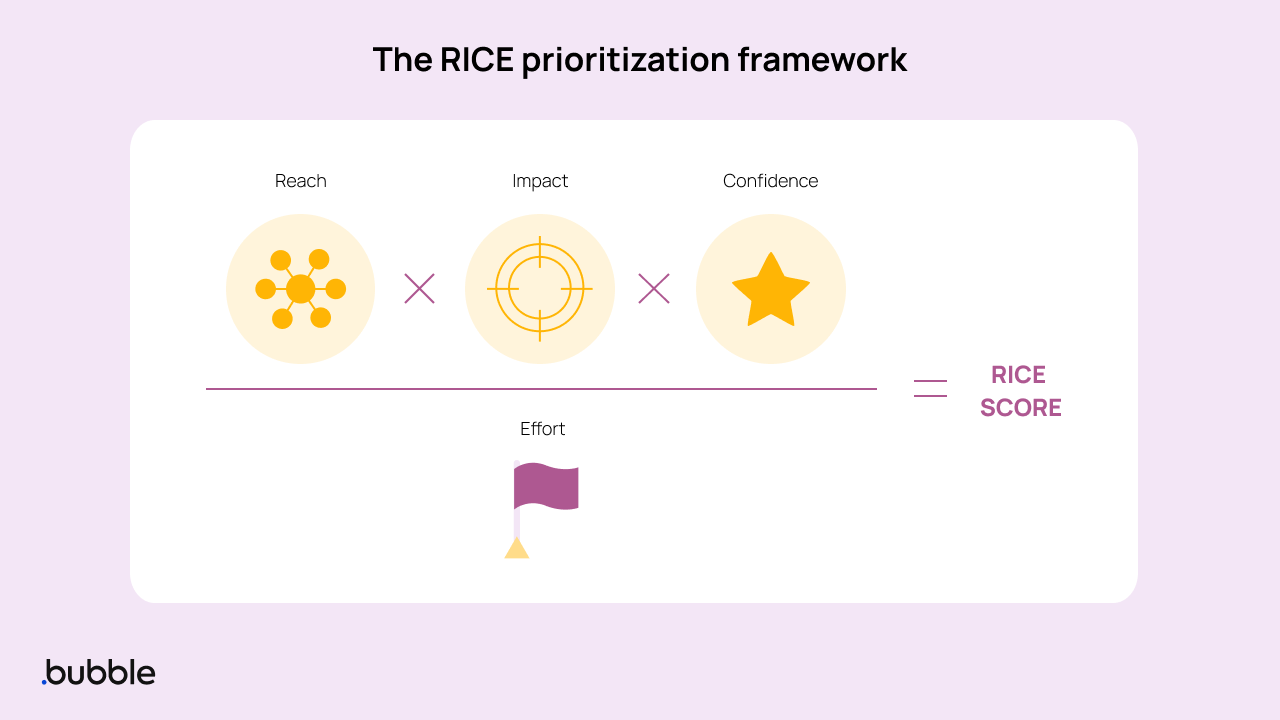 RICE prioritization framework formula: Reach × Impact × Confidence ÷ Effort = RICE Score. (Source: Bubble)
RICE prioritization framework formula: Reach × Impact × Confidence ÷ Effort = RICE Score. (Source: Bubble)Impact vs. effort matrices offer a visual alternative, plotting initiatives by value (y-axis) and effort (x-axis) to identify quick wins.
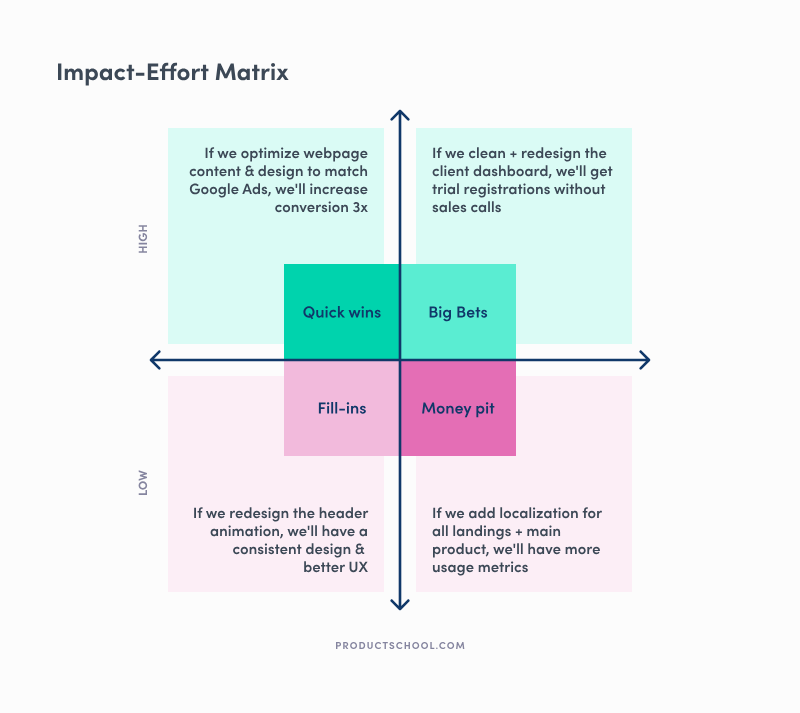 Impact-effort prioritization matrix showing quick wins, big bets, fill-ins, and money pit quadrants with examples. (Source: Product School)
Impact-effort prioritization matrix showing quick wins, big bets, fill-ins, and money pit quadrants with examples. (Source: Product School)Best for: Industries like technology, fashion, gaming, or fintech where quick, data-informed prioritization is needed across competing demands.
3. Product lifecycle management (PLM) frameworks
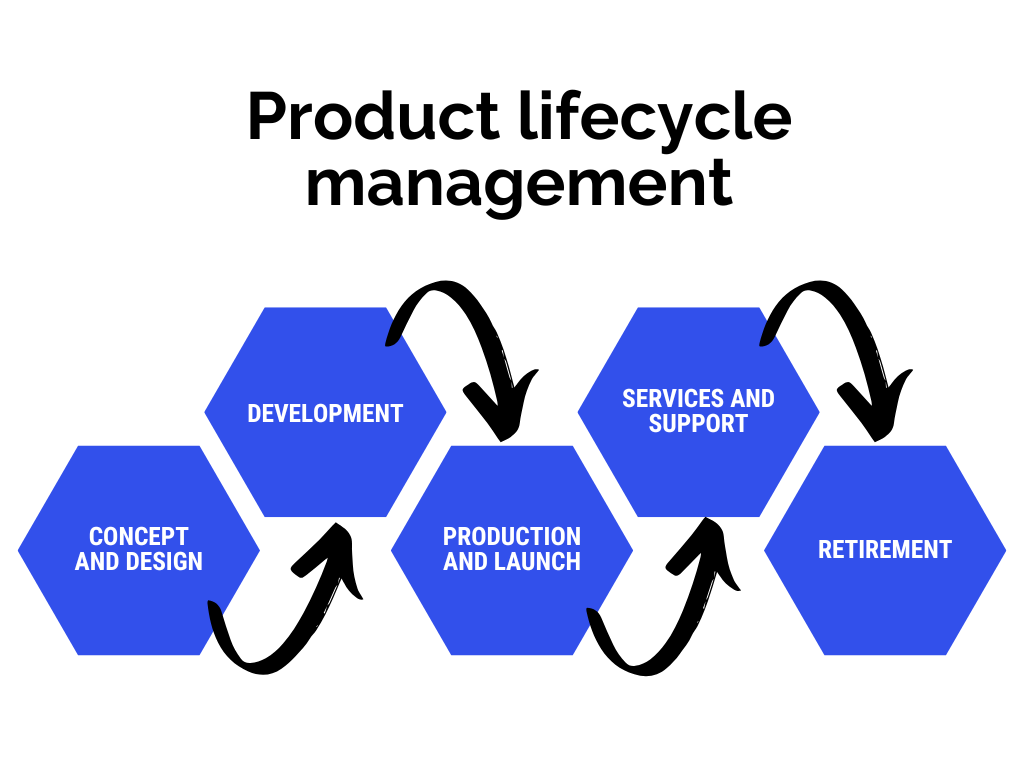 Product lifecycle management diagram showing five connected stages: concept and design, development, production and launch, services and support, and retirement.
Product lifecycle management diagram showing five connected stages: concept and design, development, production and launch, services and support, and retirement.Product lifecycle management frameworks assess where products sit in their natural stages: Introduction, Growth, Maturity, or Decline. This guides decisions on investment, repositioning, or retirement.
For example, a growth-stage product may need marketing investment, while a decline-stage product may be sunset to free resources.
Best for: Ongoing portfolio maintenance and preventing resource drain from outdated products.
Symptoms of ineffective product portfolio management
When product portfolios expand without a clear governance model, operational complexity escalates. If your teams are continuously shifting priorities, navigating resource contention, or failing to demonstrate measurable impact, it may indicate the absence of a robust portfolio management framework.
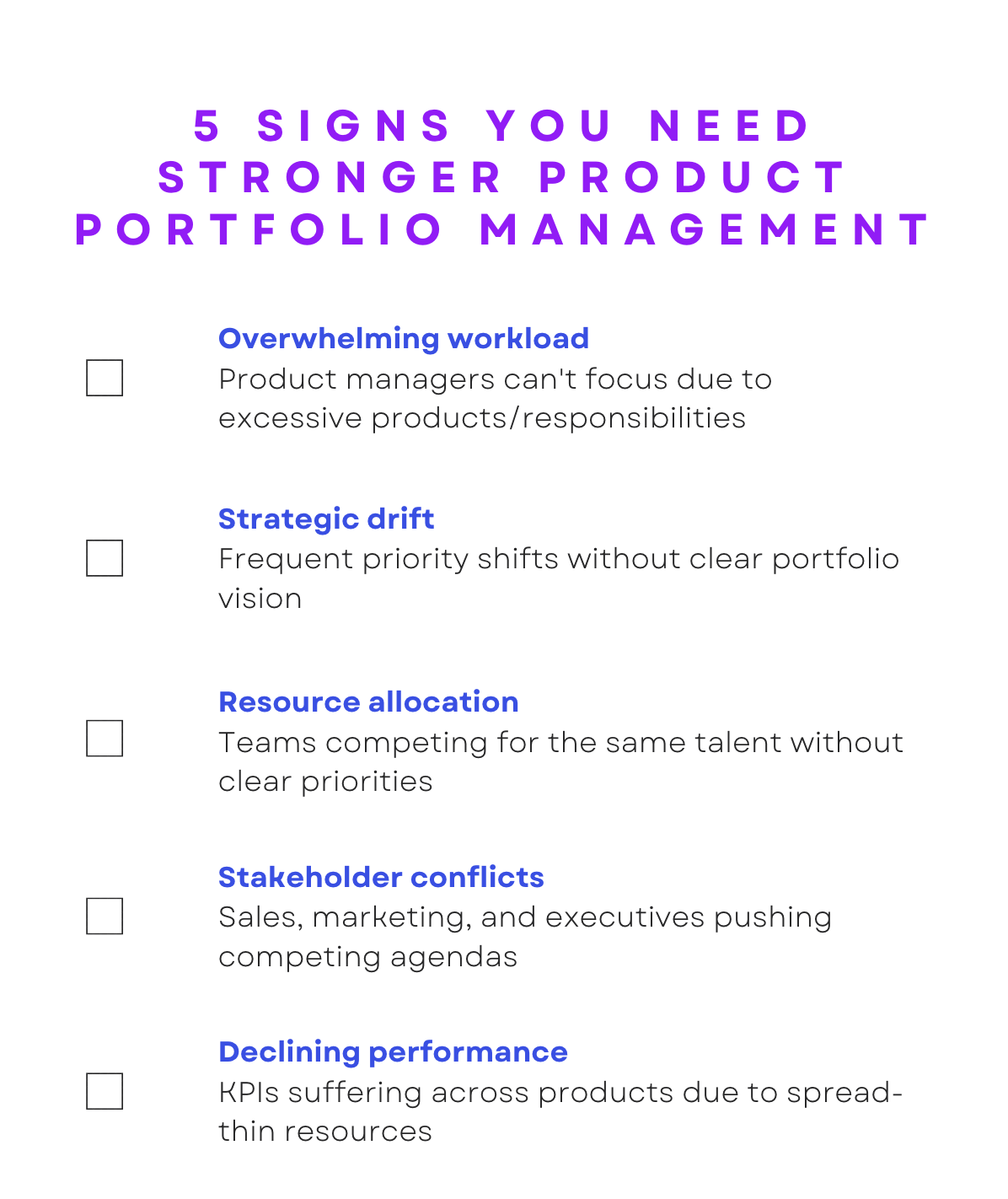 Product portfolio management checklist: key indicators that an organization needs to improve their product portfolio management practices.
Product portfolio management checklist: key indicators that an organization needs to improve their product portfolio management practices.- Overwhelming PM workload: Inability to focus due to too many products or responsibilities
- Strategic misalignment: Frequent priority shifts and lack of clear portfolio vision
- Resource allocation struggles: Teams fighting for the same resources without clear prioritization
- Stakeholder frustration: Sales, marketing, and executives all pushing competing priorities
- Metrics and performance: KPIs suffering across products due to thin resource spread
If you ticked off 3 out of the 5 points, it is imperative for your organization to implement portfolio management. Choose an approach that aligns with your company's size, industry, and maturity level.
Portfolio management strategies by organization type
Here's a quick table that outlines the PPM approach for various organizations, the recommended frameworks, purpose, with clear justification on why it works:
| Organization Type | Portfolio Approach | Recommended Frameworks | Primary Purpose | Why It Works |
|---|---|---|---|---|
| Early-stage startups | Prioritize rapid learning and focus on highest-impact bets | Opportunity scoring (RICE, Value vs. effort) | Rank opportunities by potential impact vs. effort | Helps startups invest limited resources in experiments most likely to succeed |
| Growing scale-ups | Balance new product exploration with scaling core offerings | Opportunity scoring and BCG growth-share matrix | Identify star products vs. emerging opportunities | Helps scale-ups allocate resources between innovation and doubling down on winners |
| Mature enterprises | Optimize large portfolios for ROI and strategic alignment | GE-McKinsey nine-box matrix and Product Lifecycle Management (PLM) | Prioritize based on business strength and market attractiveness | Supports disciplined investment and resource allocation across a complex portfolio |
| Sectors with fast-changing consumer trends | Maintain agility through frequent reassessment | Lightweight scoring models (rapid RICE, custom scoring) | Quickly re-prioritize based on new data | Enables teams to adapt fast without reworking the entire portfolio strategy |
| Manufacturing and physical products | Manage long product cycles and inventory risks | Product Lifecycle Management (PLM) and Strategic Mapping | Plan for product introductions, growth, maturity, and retirement | Reduces waste and maximizes profitability across physical goods lifecycles |
| SaaS and digital products | Drive subscription growth, minimize churn, and enable fast iteration | BCG growth-share matrix | Identify when to scale, pivot, or sunset products | SaaS portfolios require quick market response — these tools guide investment timing |
| B2B vs. B2C companies | Adjust to buying cycle speed and customer behavior | B2B: McKinsey Nine-Box; B2C: RICE framework | Align to slower (B2B) or faster (B2C) product feedback loops | Reflects the urgency or patience needed in different customer segments |
Once you've identified the right approach for your company, the next step is building a systematic implementation plan that brings these frameworks to life.
Cookie-cutter templates don't work. These from Meegle do.
Meegle offers industry-tailored solutions with essential factors already built in for your specific use case. Simply personalize and implement:
- Portfolio Risk Heatmap Dashboard - Pre-configured risk assessment criteria for your industry
- Feature Management Template - Complete feature lifecycle with industry-standard workflows
- Agile Development Template - Epic, Story, Sprint management optimized for development teams
Best practices on building a product portfolio management system
Creating an effective product portfolio management system transforms common organizational problems into coordinated decision-making aligned with business objectives. This includes situations like launching multiple products that cannibalize each other's sales or having different teams unknowingly develop similar features. This structured approach ensures teams focus on high-impact products while maintaining portfolio balance.
Choose the right organizational structure
Your organizational model determines how portfolio decisions flow through the company. Two primary approaches exist:
- Centralized structures consolidate portfolio authority under a single team or executive. This model excels at maintaining consistent strategy and resource allocation across product lines. Large enterprises often benefit from this approach when coordination across diverse product teams is essential.
- Distributed structures empower individual product teams with decision-making authority. This creates greater agility and responsiveness to market changes but risks strategic misalignment. Startups and mid-sized companies frequently adopt this model to maintain speed and innovation.
Regardless of structure, clearly defined decision rights are critical. Document who approves new product investments, who determines resource allocation, and who makes sunset decisions. Without these guardrails, even well-designed portfolio systems falter under ambiguous authority.
Implementation steps
Building a functional product portfolio management system requires methodical execution:
Step 1. Create a comprehensive product inventory: Catalog every product and initiative, documenting key attributes like revenue, market share, and lifecycle stage. This baseline assessment reveals portfolio gaps and overlaps.
Step 2. Establish performance metrics: Define how you'll evaluate product success through financial metrics (ROI, revenue growth), customer metrics (NPS, retention), and strategic alignment indicators.
Step 3. Align with business strategy: Map products to strategic priorities such as market expansion, competitive differentiation, or operational efficiency.
Step 4. Design governance processes: Determine review cadences, decision thresholds, and escalation paths. Quarterly portfolio reviews supplemented by monthly check-ins provide adequate oversight without excessive meetings.
Step 5. Roll out incrementally: Implement your system in phases over three to six months, allowing time for stakeholder buy-in, data collection, and process refinement.
By institutionalizing these practices, organizations not only gain control over their product landscape but also create conditions for more deliberate, high-impact decision-making at scale.
Cross-functional collaboration framework
Effective portfolio management requires seamless coordination across departments, including:
- Product-finance alignment ensures investment decisions reflect both market opportunity and financial constraints. Regular budget reconciliation prevents resource allocation surprises.
- Product-marketing coordination synchronizes product development with go-to-market planning. This partnership prevents the common problem of completed products sitting idle without proper launch support.
- Product-engineering integration balances technical feasibility with market requirements. Clear communication channels prevent scope creep and unrealistic timelines.
Establishing cross-functional alignment is essential, but even well-coordinated teams struggle when resources are spread too thin or allocated to the wrong initiatives. The key is translating coordination into concrete resource allocation decisions that maximize portfolio value.
Managing resource allocation across your product portfolio
How you allocate people, budget, and time directly influences your portfolio's outcomes. Use these four practices to optimize resource allocation and drive delivery and innovation:
1. Prioritize resources effectively
Effective resource allocation starts with a clear view of capacity. Begin by mapping all teams, roles, and their realistic availability. Account for non-project time including meetings, administrative tasks, training, and vacation. Then forecast upcoming work across your portfolio.
Pay close attention to shared resources that appear across multiple projects—these often become bottlenecks. If they’re overbooked, project timelines will slip.
In manufacturing, this might be your quality assurance team that must certify every product variant. In pharmaceuticals, it could be your regulatory affairs specialists who handle approvals across multiple drug candidates. In consumer goods, packaging designers often support numerous product lines simultaneously.
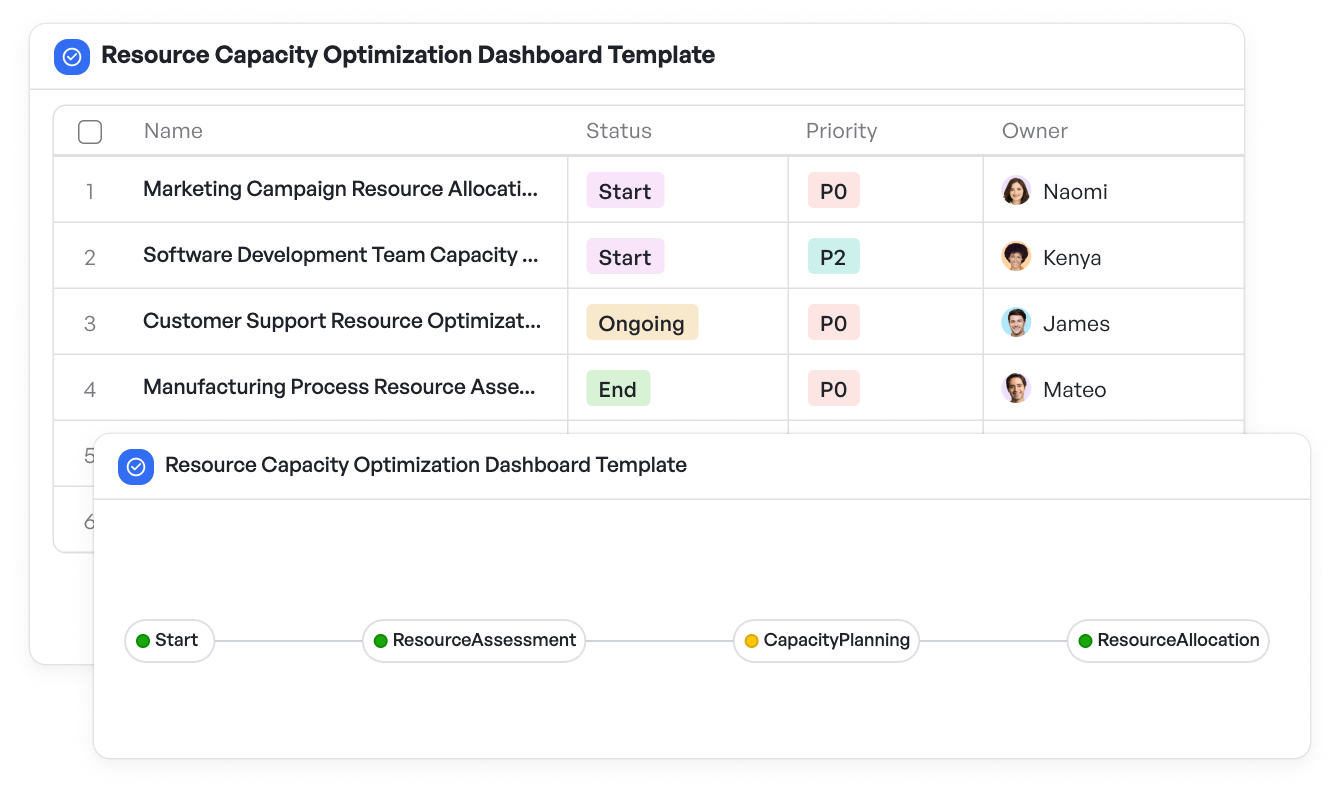
Meegle’s Resource Capacity Optimization Dashboard Template uses a person-day (PD) estimation model to show real-time workload and availability. The calendar view aligns with your project workflow, while automated alerts flag scheduling conflicts and potential delays before they impact delivery.
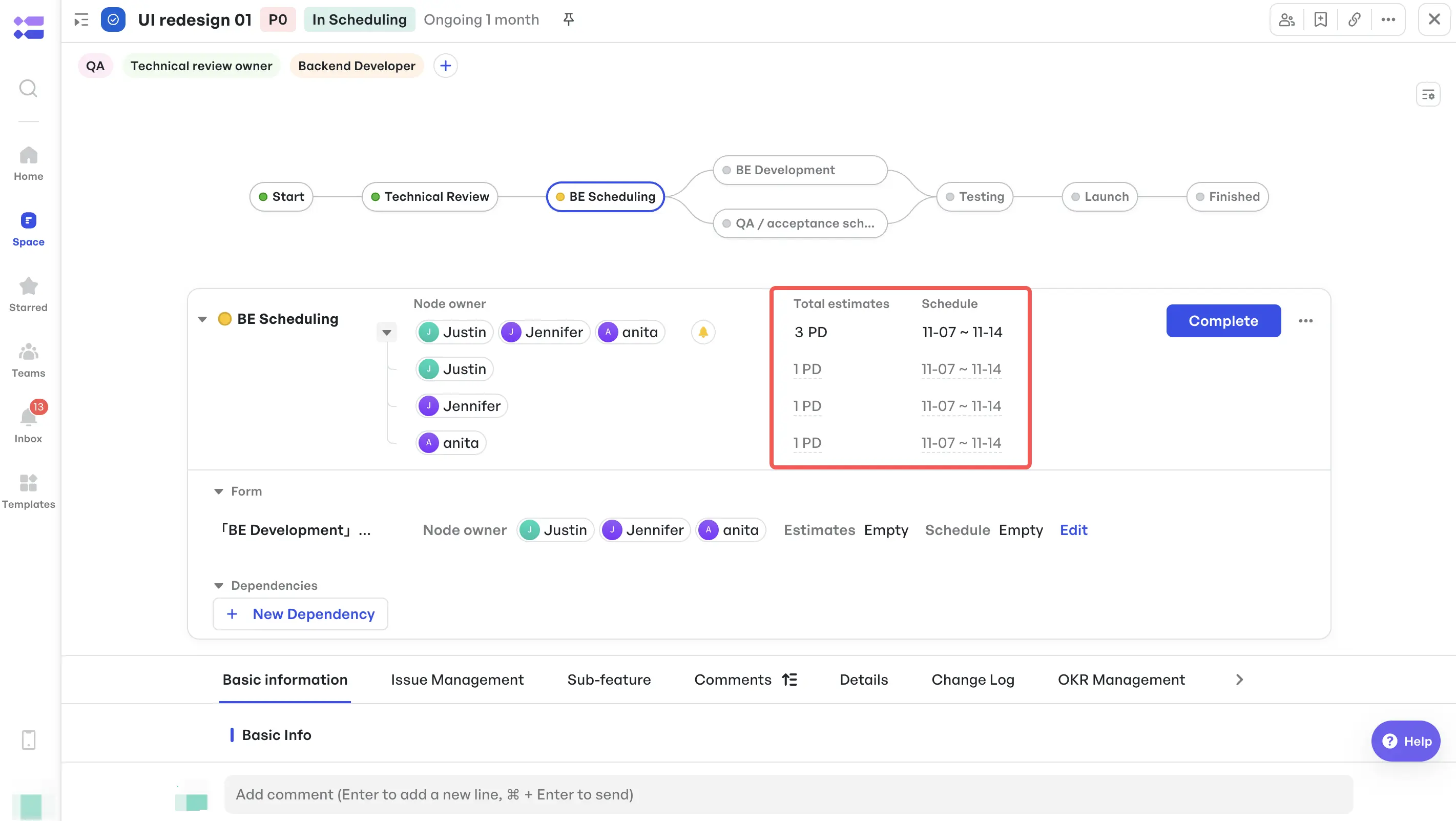
For example, if your food scientists are assigned to both a new snack line development and beverage reformulation project, the template highlights the overlap and shows exactly when conflicts occur.
This early visibility allows teams to make informed decisions about resource allocation before bottlenecks derail multiple product launches.
2. Investment mix: balance portfolio decisions with business goals
A healthy product portfolio's core foundation is balance. Over-invest in maintenance, and growth stalls. On the other hand, if you focus primarily on transformation, your core products will weaken.
Many companies face resource allocation inertia. About one-third of capital allocation remains essentially fixed despite shifting market conditions.
Manufacturers encounter production bottlenecks when launching multiple variants simultaneously. Consumer goods companies wrestle with R&D resource conflicts across competing product lines. Technology firms often waste engineering capacity due to poor coordination between development teams.
To manage this, organize portfolio investments into three buckets:
- Maintain (50%): Sustain mature products generating steady revenue
- Grow (30%): Scale high-potential products showing market traction
- Transform (20%): Develop innovative offerings for future growth
This distribution provides a starting framework. Optimal ratios vary by industry maturity and competitive landscape. For instance, tech firms often allocate more to growth initiatives, while regulated industries require higher maintenance investment.
However, having allocation percentages means nothing without processes to apply them objectively. Meegle's Capital Allocation Strategy Template operationalizes these decisions through structured evaluation workflows.
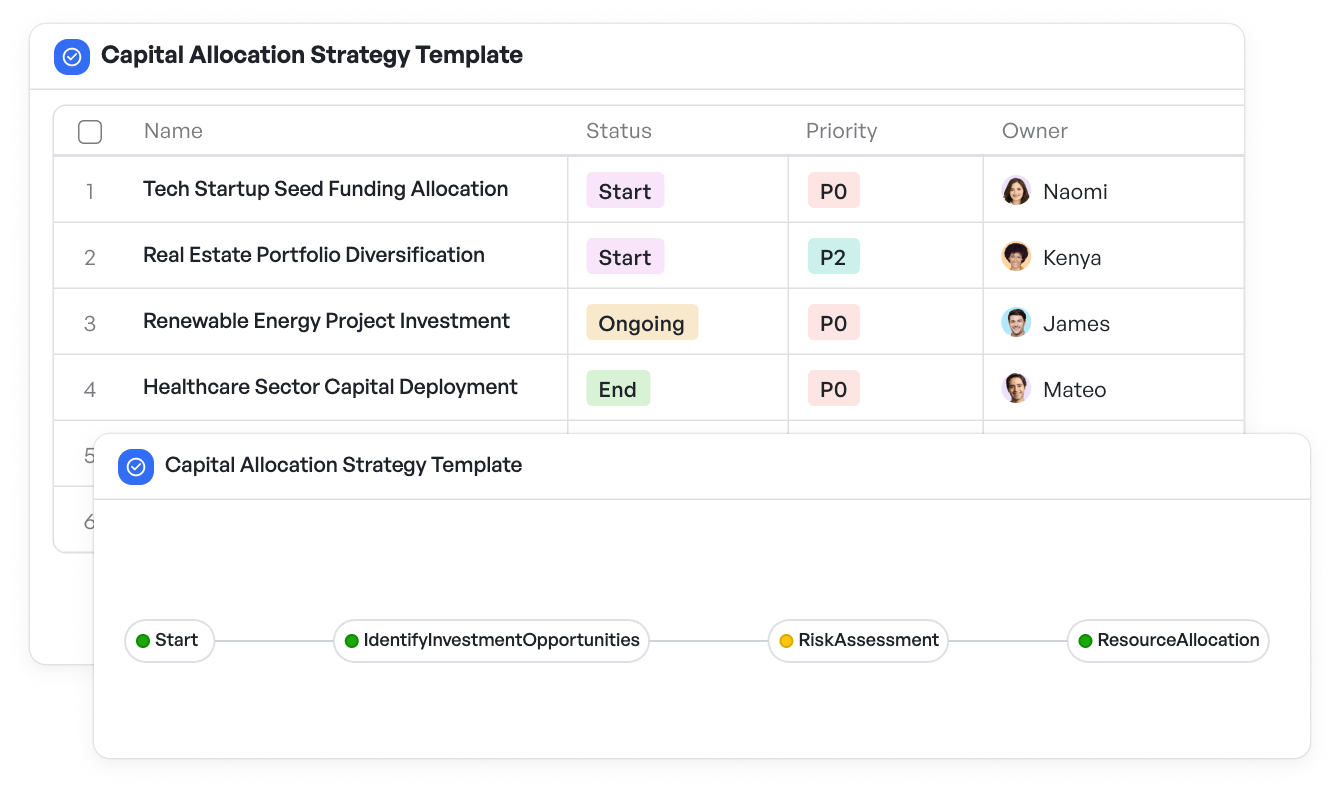
In this template, you can score each initiative against specific criteria: market size and growth potential, competitive positioning impact, required investment timeline, and resource dependency risks.
When your flagship mobile product needs expanded features while a new IoT product line awaits launch approval, the template forces you to quantify both opportunities rather than defaulting to whoever presents the most compelling narrative.
The template directly addresses common product portfolio management pain points, including:
- Over-investing in incremental improvements to mature products while neglecting innovations.
- Spreading resources across too many concurrent product initiatives without adequate focus.
- Making investment decisions based on internal politics rather than market potential.
You can track decision outcomes, compare actual product performance against initial projections, and refine evaluation criteria based on which investments actually delivered portfolio growth with this template. This creates institutional learning that improves future allocation decisions.
3. Map capacity constraints
Quantify available resources against product demands by documenting team capacity, specialized skills, and departmental bandwidth. This reveals critical bottlenecks, such as resources being simultaneously required across multiple product initiatives.
Meegle's automation framework prevents resource conflicts through trigger-and-condition-based automation capabilities. Product managers can designate backup team members for critical tasks using triggers and conditions that activate when primary assignees become unavailable.
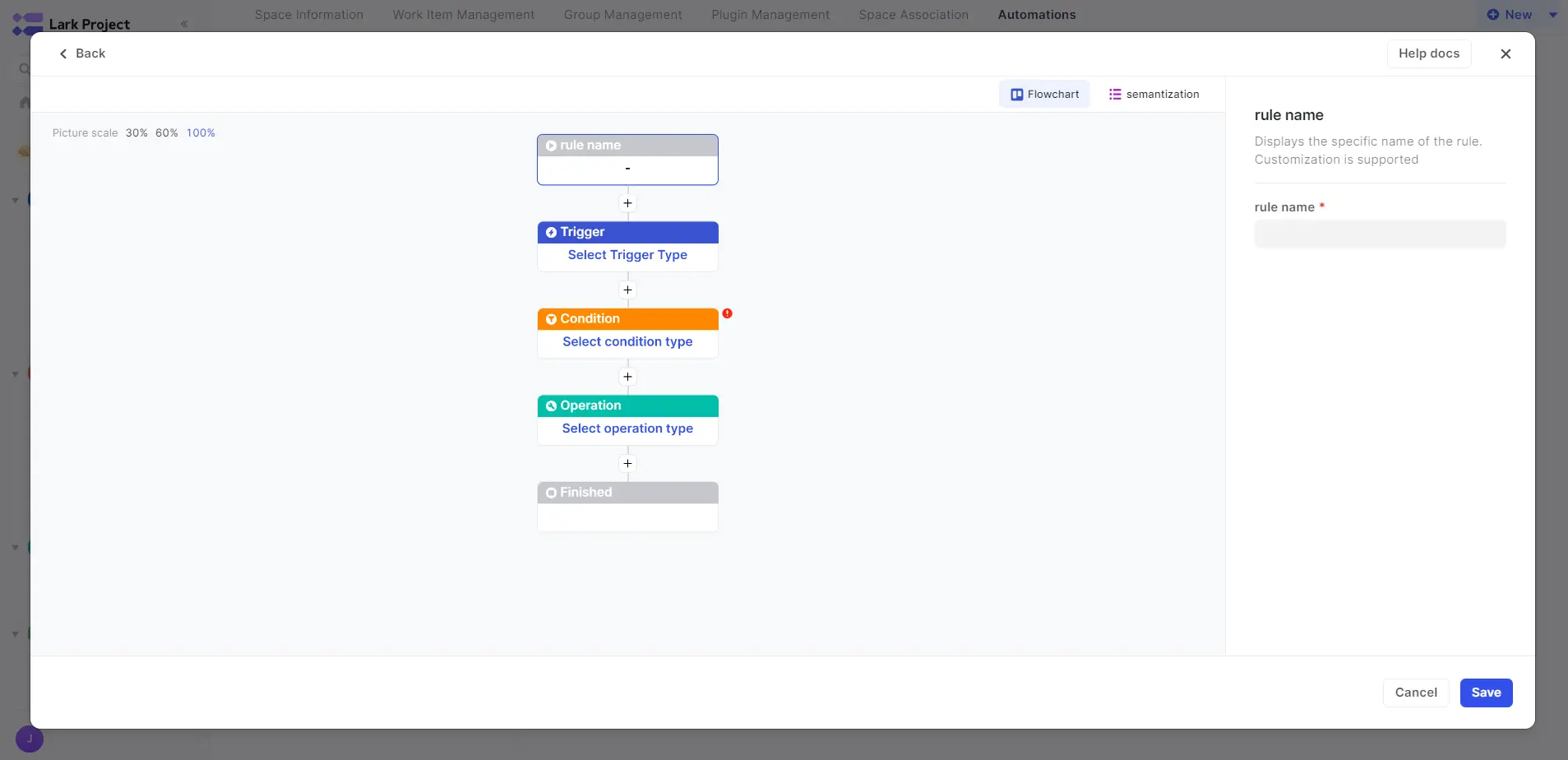
When your lead product specialist is scheduled for both a product line extension, and a new category launch, the automation system immediately reassigns tasks to your pre-selected backup specialist when scheduling conflicts arise. Meegle offers automation triggers covering scenarios from due-date reminders to automatic rollback triggers when a feature is terminated, eliminating manual intervention in resource reallocation.
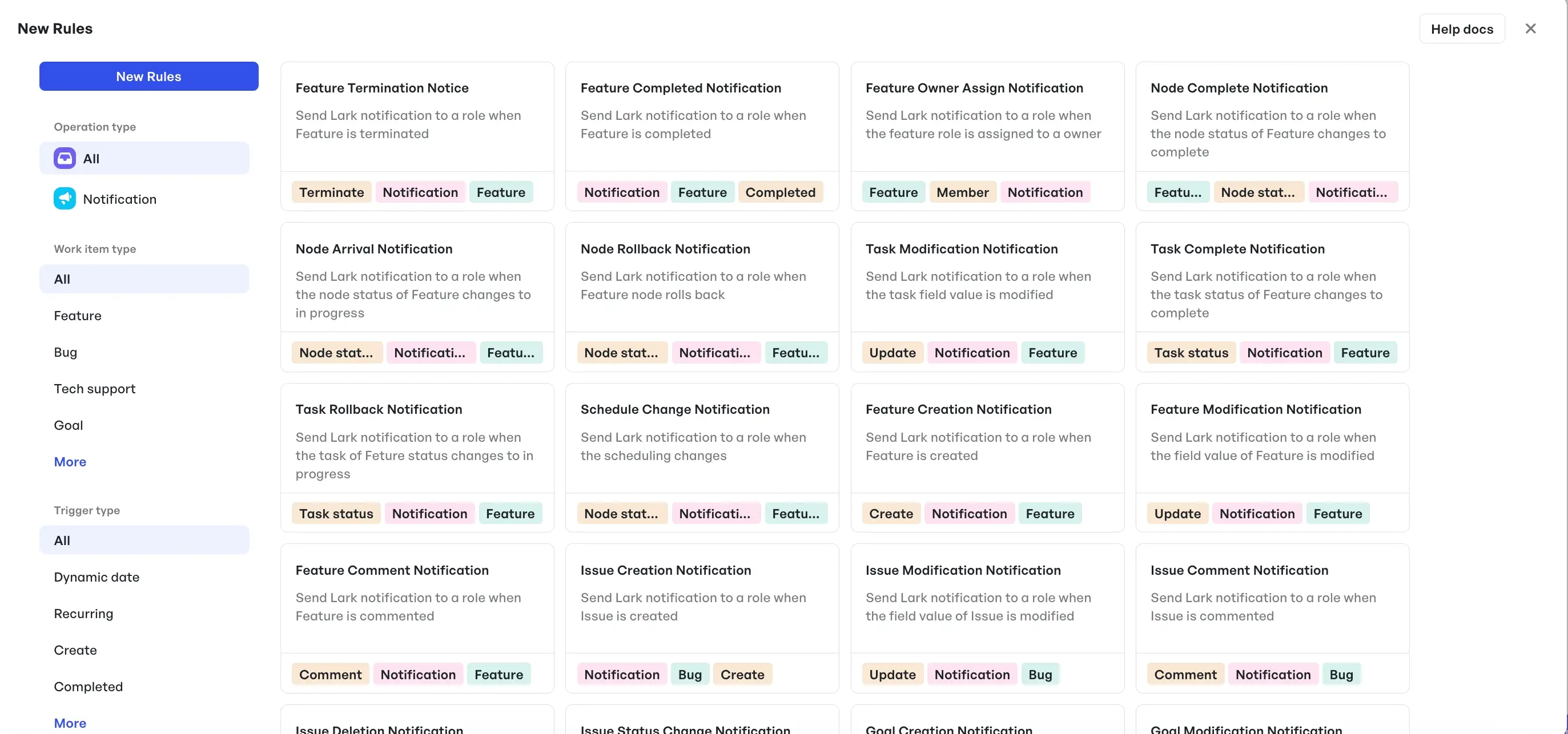
The member schedule feature provides real-time visibility into team capacity across multiple product portfolios through person-day (PD) tracking and Gantt Chart visualization. Product portfolio managers can view workload distribution across team members, identify over-allocation before it impacts delivery, and dynamically adjust assignments based on actual capacity.

Meegle then aggregates scheduling information from multiple spaces and work items, showing exactly which team members have more bandwidth.
The scheduling functionality combines visual workflow management with intelligent capacity planning through two calculation methods: "Aggregate by individuals" for refined resource management where each team member fills in their own schedules, and "Dynamic calculation" that automatically distributes workloads based on overall project requirements.
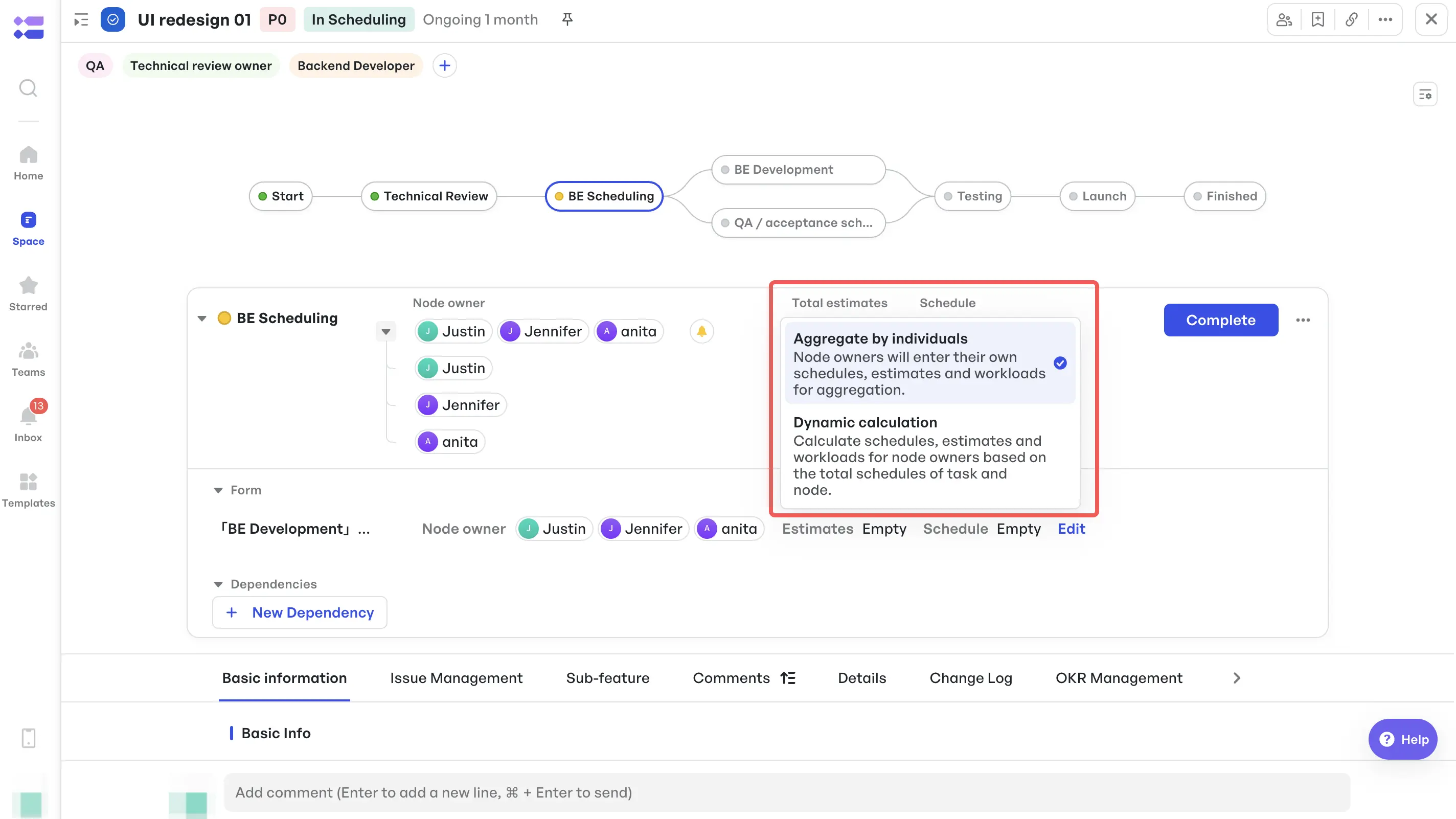
The system includes work schedule configuration that accommodates different corporate calendars, ensuring capacity calculations reflect actual availability rather than theoretical full-time equivalents.
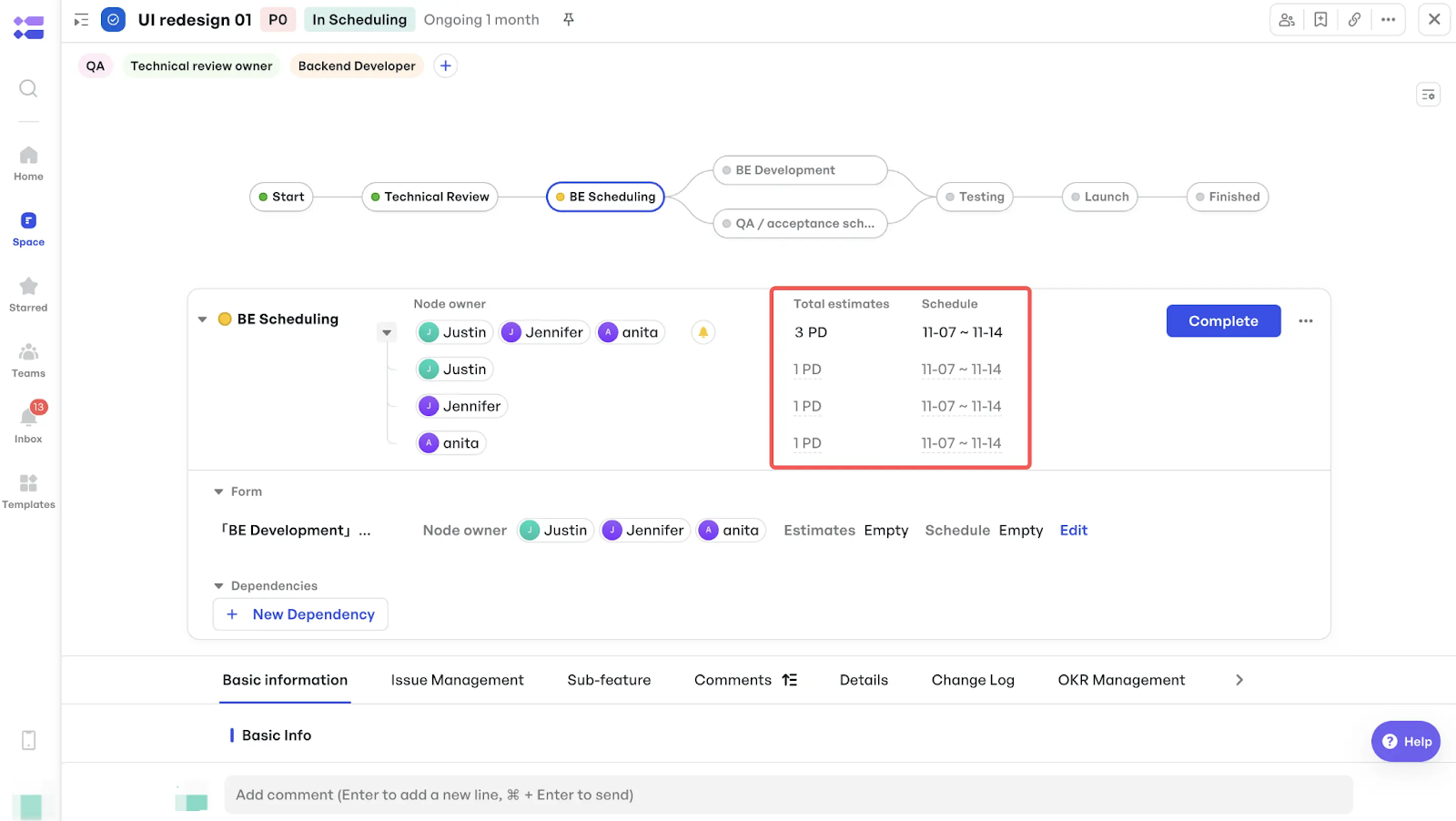 Meegle's workflow interface shows visual task progression, team assignments, and resource allocation for a project.
Meegle's workflow interface shows visual task progression, team assignments, and resource allocation for a project.4. Track allocation effectiveness
Measure resource efficiency through these key metrics:
- Portfolio ROI (comparing product performance against resource investment)
- Time-to-market variance (identifying allocation decisions that accelerate or delay launches)
- Innovation-to-maintenance ratio (ensuring sufficient investment in future growth)
Charts provide real-time dashboard visualization of these portfolio metrics through customizable templates including pie, line, bar, and funnel diagrams.
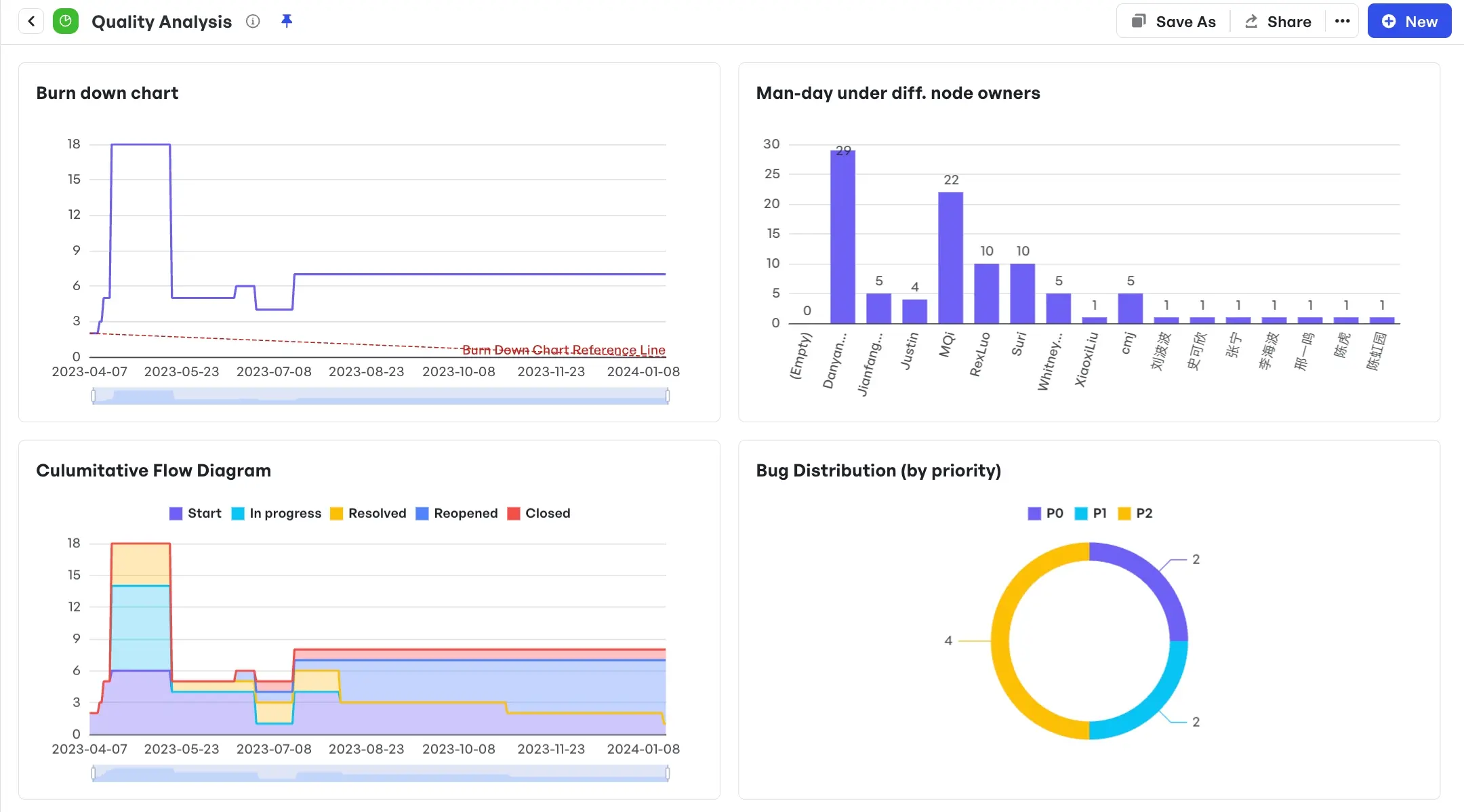 Customizable, real-time, and easily shareable across teams charts in Meegle
Customizable, real-time, and easily shareable across teams charts in MeegleYou can track resource allocation effectiveness across multiple product lines, compare actual performance against projected returns, and identify patterns that indicate which investment decisions will consistently deliver portfolio growth.
Regular reviews of these indicators enable continuous optimization of resource distribution. Historical data analysis improves future allocation accuracy and strategic decision-making for maximum portfolio value.
Measuring portfolio management success
Effective product portfolio management hinges on measurable outcomes. By tracking portfolio-level metrics, teams ensure sustained health and alignment with business goals. Meegle’s charts provide real-time insights to monitor these metrics.
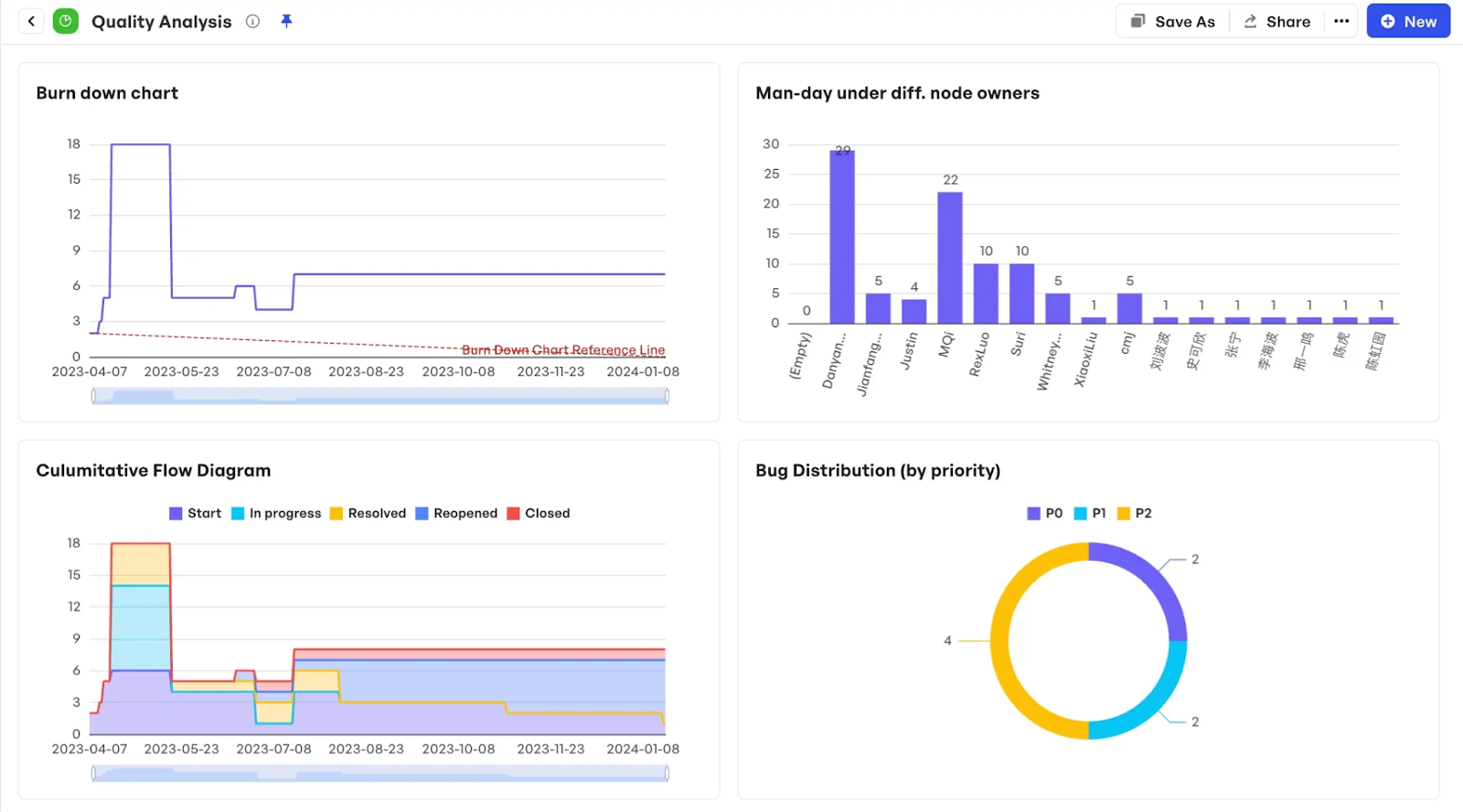 Meegle's customizable charts showing project progress, resource allocation, task status transitions, and bug distribution by priority levels (P0, P1, P2).
Meegle's customizable charts showing project progress, resource allocation, task status transitions, and bug distribution by priority levels (P0, P1, P2).- Portfolio-level metrics: KPIs like portfolio ROI, revenue growth, or market share reflect overall health.
- Value realization tracking: Measure outcomes against decisions, such as whether a new product met its revenue target. This validates strategic choices.
- Resource optimization measures: Metrics like resource utilization rate (e.g., 85% team capacity used) or cost efficiency ensure resources are allocated effectively.
- Strategic alignment indicators: Track the percentage of initiatives supporting company goals (e.g., 80% aligned with market expansion).
Suggested read: 👉11 Product Management KPIs in 2025 [+ How to Track Them]
These metrics provide a clear picture of portfolio performance, guiding data-driven adjustments.
Common portfolio management challenges + solutions guide
Even the best-designed portfolio management systems encounter obstacles. In this section, we’ll explore how Meegle can help modify common roadblocks into opportunities for greater portfolio alignment and performance.
Challenge 1: Leadership constantly shifting priorities
Leadership-driven shifts in priorities cost organizations billions each year due to resource inefficiencies, burnout, and misaligned execution. McKinsey & Company notes that 20–30% of priorities are adjusted each quarter by halting low-value work. Without proper context, these changes disrupt momentum, delay outcomes, and reduce confidence in leadership.
The challenge lies in limited visibility and poor retention of past decisions. Teams function independently, historical context gets lost, and the link between strategy and daily work remains unclear.
Solution: A structured portfolio governance system that maps strategic goals to individual tasks and preserves decision history through visual hierarchies and audit trails.
Here is how Meegle helps:
Panorama view
Meegle's panorama view solves the fundamental visibility crisis that drives knee-jerk priority decisions through its advanced tree view layout. It enables you to view multiple work items from different spaces at once.
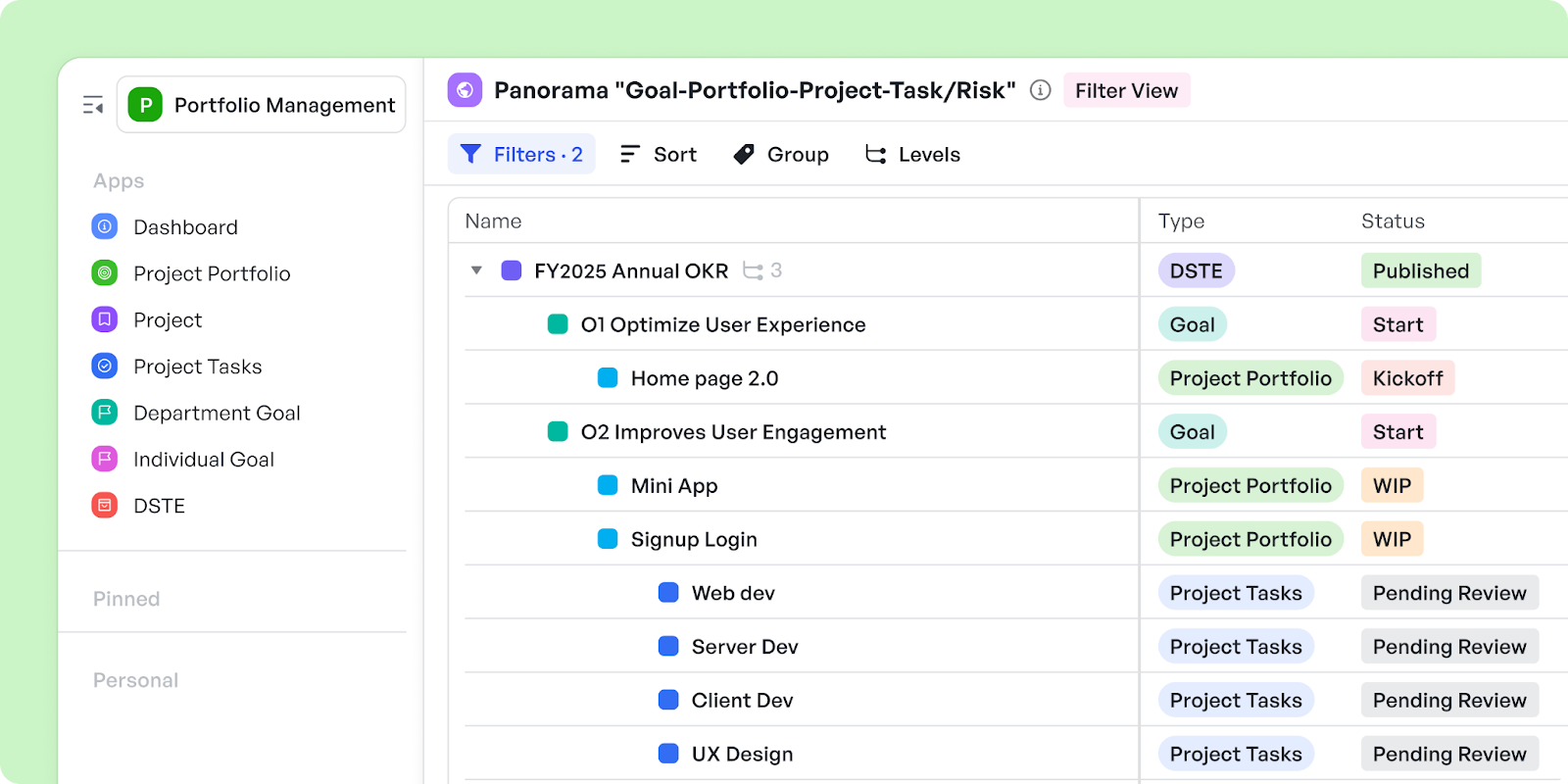 Meegle's panorama view shows a hierarchical product portfolio structure linking annual OKRs to goals, projects, and tasks with their current status.
Meegle's panorama view shows a hierarchical product portfolio structure linking annual OKRs to goals, projects, and tasks with their current status.Meegle's panorama view shows a hierarchical product portfolio structure linking annual OKRs to goals, projects, and tasks with their current status.
When any element changes—whether a task completion, resource reallocation, or deadline shift—the entire hierarchy updates in real time across all stakeholder views. The expandable tree visualization allows leaders to navigate from 30,000-foot strategic view down to individual task details without losing context. Color-coded status indicators provide immediate visual feedback across all levels.
While this shows strategic-to-tactical alignment, deeper interdependencies across products are handled via Meegle’s interdependency mapping.
OKR project management
Meegle's OKR project management eliminates the gap between strategic goal-setting and operational execution by connecting every task directly to measurable strategic outcomes. Unlike standalone OKR platforms that operate in isolation, Meegle's integrated workflow ensures your daily work always ladders up to company objectives.
Link tasks, projects, and initiatives directly to OKRs, so teams understand how their work contributes to strategic goals.
When leaders set annual objectives, the template-based structure automatically suggests goal decomposition using SMART framework implementation.
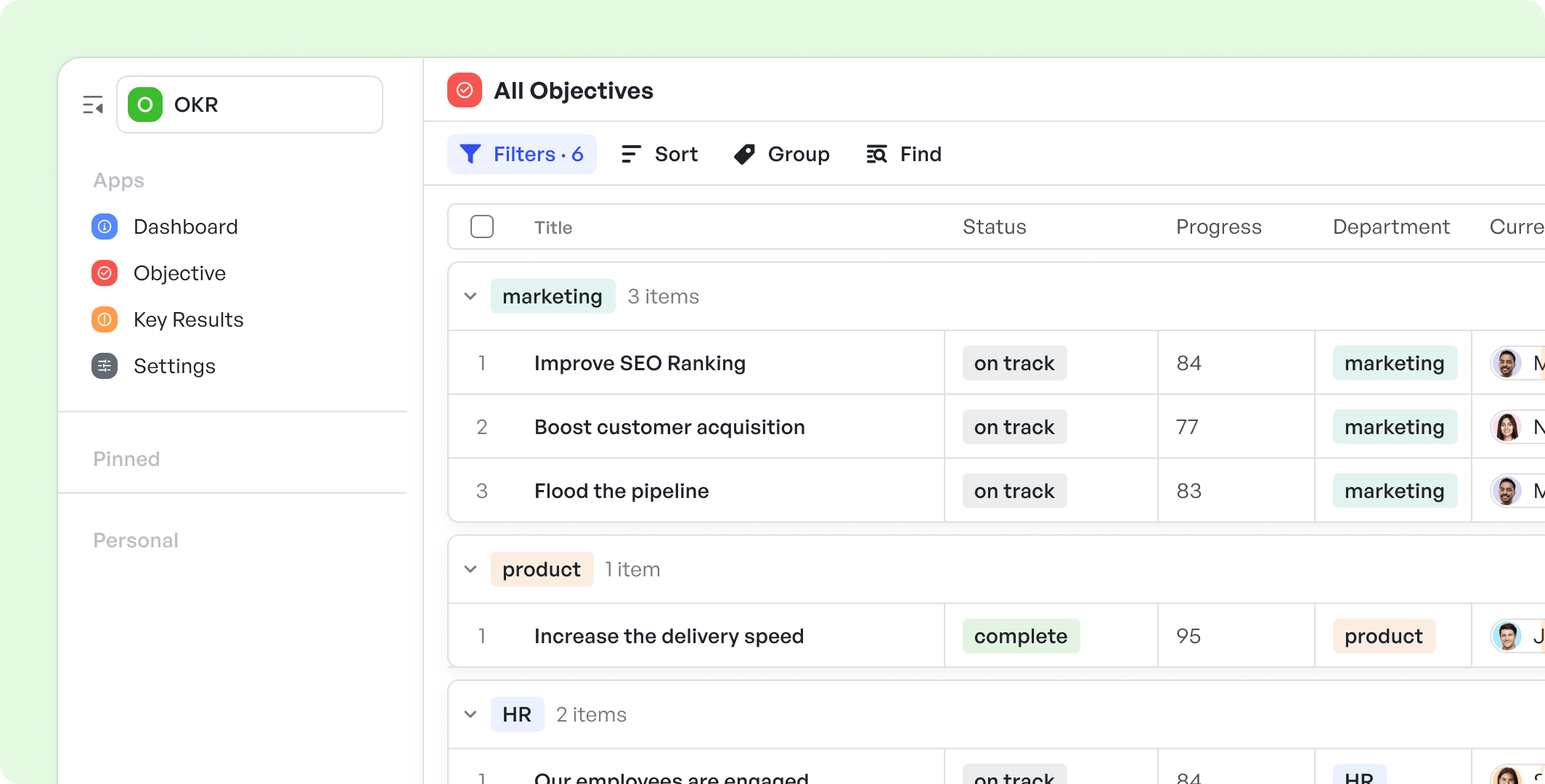 OKR template in Meegle
OKR template in MeegleFormula-based progress calculations monitor task completion rates and milestone achievements, then calculate objective completion percentages in real-time, eliminating manual reporting overhead.
The confidence tracking mechanism adds a psychological dimension where team members indicate their confidence level in achieving key results. The system aggregates these assessments to provide leadership with risk-weighted portfolio forecasts, combining quantitative completion data with qualitative probability assessments.
Prioritization frameworks
Meegle supports RICE within its product backlog management. Product managers calculate RICE scores—assessing Reach (users affected), Impact (business value), Confidence (data reliability), and Effort (resources needed)—and assign priorities (P0, P1). This structured approach ensures decisions remain consistent, even under pressure.
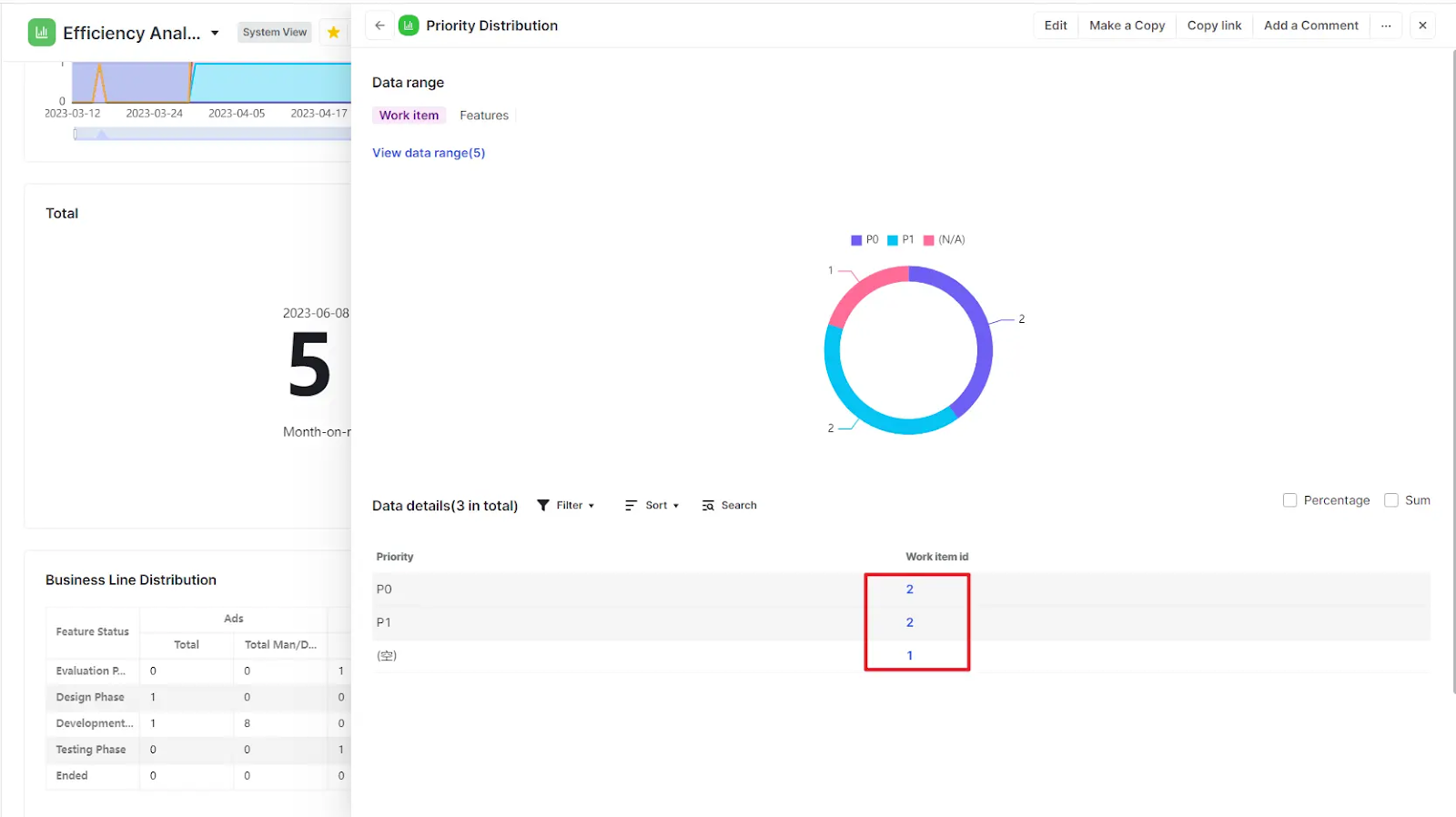 Meegle's priority distribution dashboard shows work item allocation across priority levels (P0, P1) with a circular chart and tabular data.
Meegle's priority distribution dashboard shows work item allocation across priority levels (P0, P1) with a circular chart and tabular data.Challenge 2: Burnt-out product managers
Product managers often juggle multiple initiatives, leading to burnout, diluted focus, and delayed deliveries. The 2023 State of Product Management Annual Report found that:
Over 50 percent of large product teams (50 people or more) cite “keeping roadmaps and processes consistent” as the number one growing pain.
Overloaded with tasks across products, PMs struggle to prioritize, impacting portfolio performance and team morale.
Solution: Sustainable workloads require effective delegation and clear visibility into team capacity and task dependencies. By assigning responsibilities and monitoring team capacity, you can focus on high-impact work, reducing stress and improving efficiency.
You can achieve this through Meegle:
Task management and delegation
Meegle stands out as a visual workflow & project management tool that directly addresses PM burnout through sophisticated task delegation and capacity planning features. Unlike traditional project management tools, Meegle's node-driven workflow breaks complex projects into interconnected visual elements with input and output ports. This creates complete workflows where each task's dependencies and handoffs are clearly mapped.
Meegle offers four distinct assignment methods that give PMs flexibility in how they distribute work:
1. Role-based assignment aligns tasks with predefined roles (Product Owner, Scrum Master, Developers, etc.) and allows dynamic reassignment as needed.
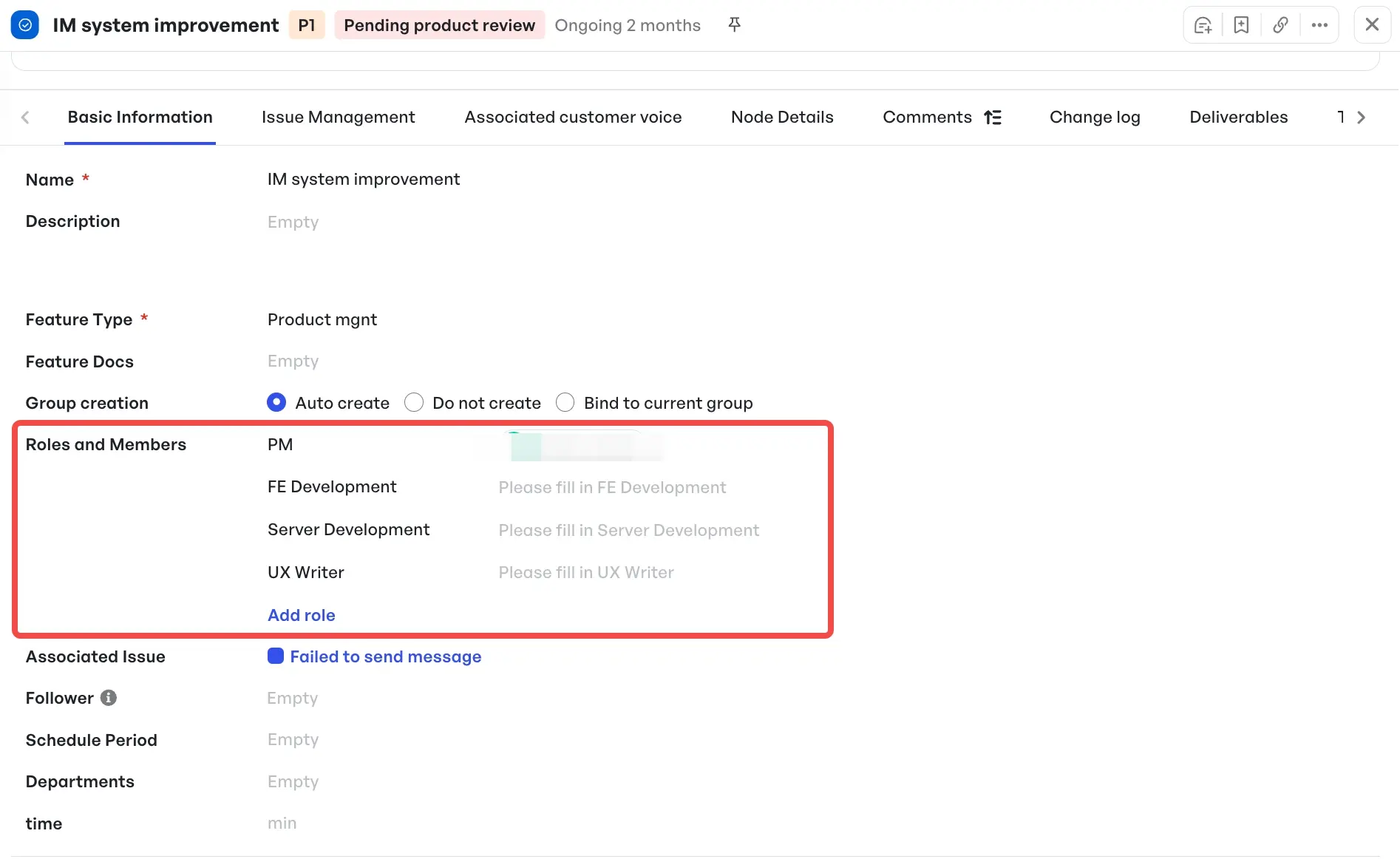 Assigning roles in Meegle
Assigning roles in Meegle2. Default assignment automatically routes tasks to designated team members based on predefined criteria such as skill sets, availability, and priority levels.
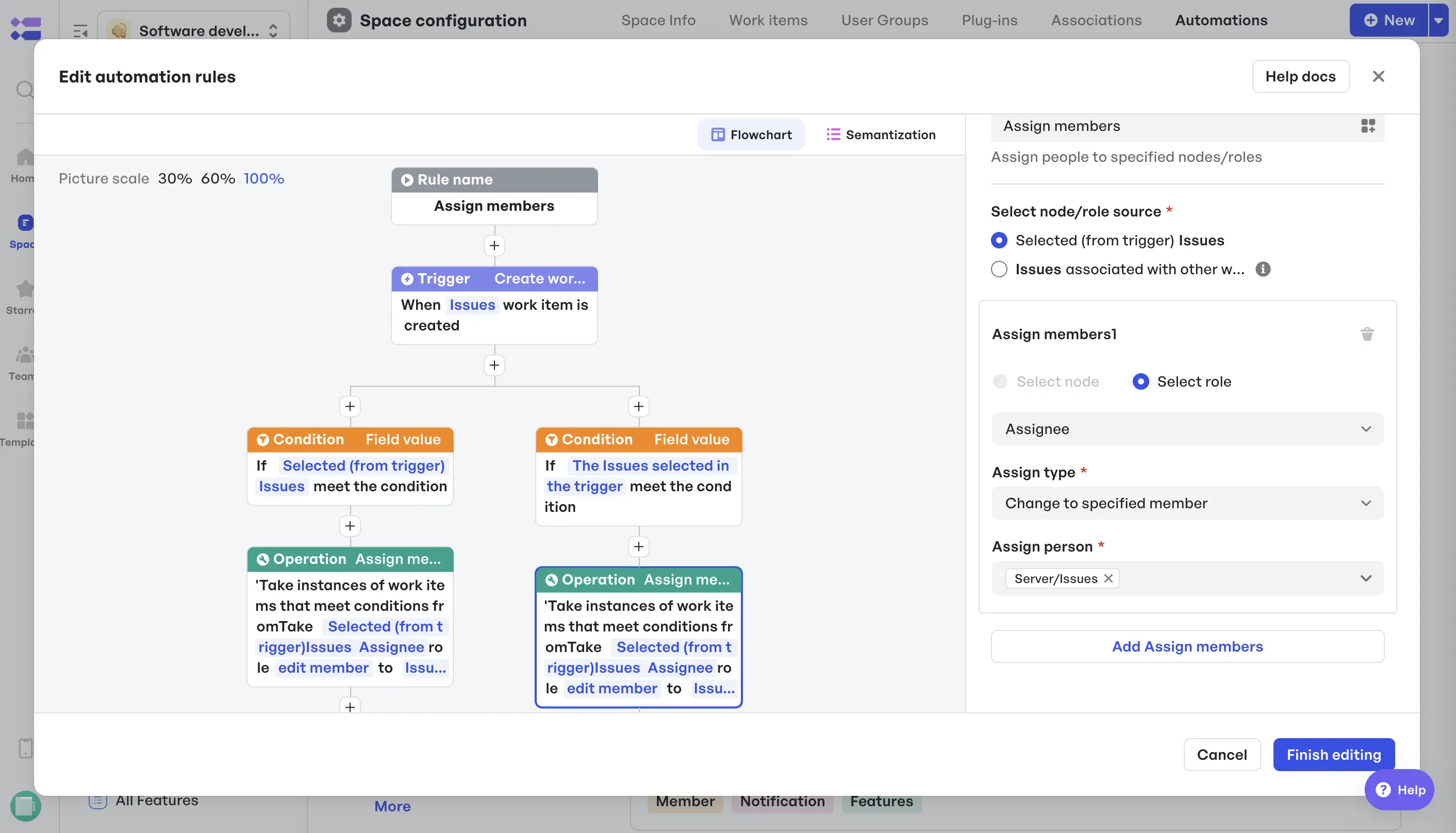 Automation rules to assign issues to team members in Meegle
Automation rules to assign issues to team members in Meegle3. Conditional assignment triggers task distribution based on predefined business rules and criteria.
4. Manual assignment provides direct control for specific situations requiring PM intervention.
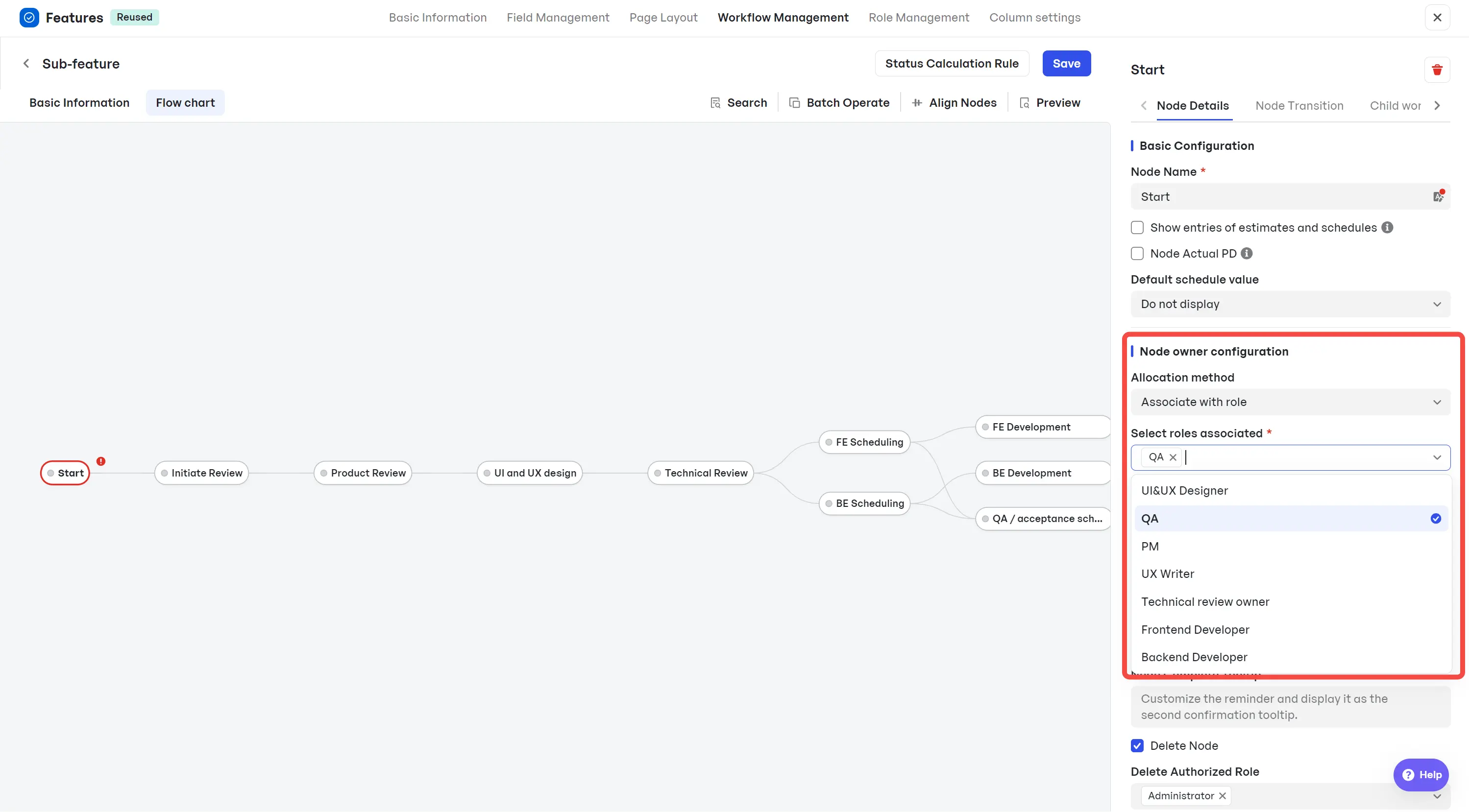
5. Automated workflows reduce manual follow-ups by routing tasks, updating timelines, and notifying teams—freeing PMs from status-chasing and allowing them to focus on high-impact decisions.
Resource planning views
Calendar view with real-time capacity planning displays team member schedules and workloads visually, enables you to allocate resources based on actual availability.
At a glance, you can see who's overloaded and who has capacity for additional work.
Meegle supports multiple specialized views tailored to different aspects of capacity management:
- Gantt View monitors project timelines and commitments.
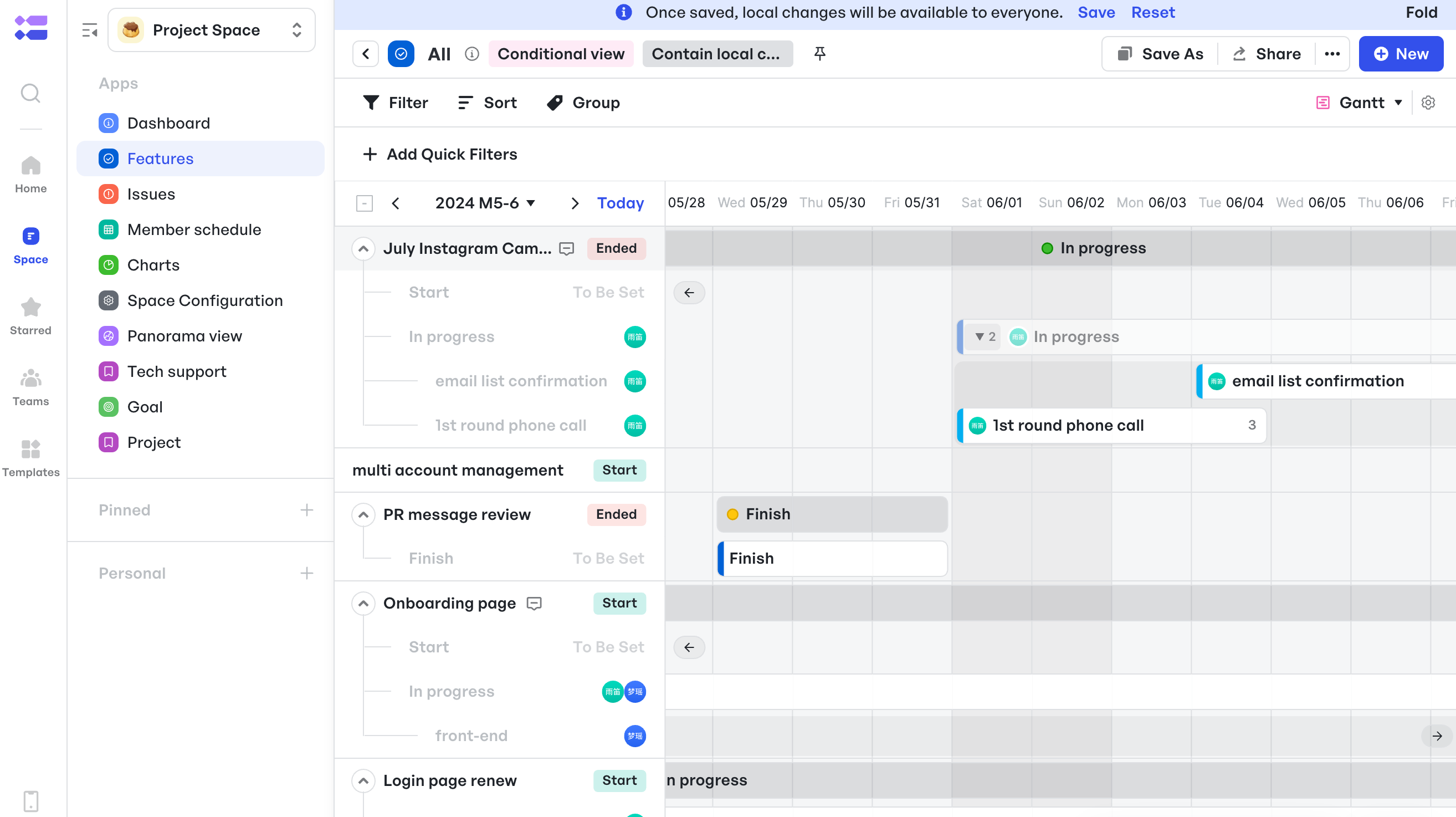
- Tree View breaks down large projects with multi-level structure for complex resource allocation.
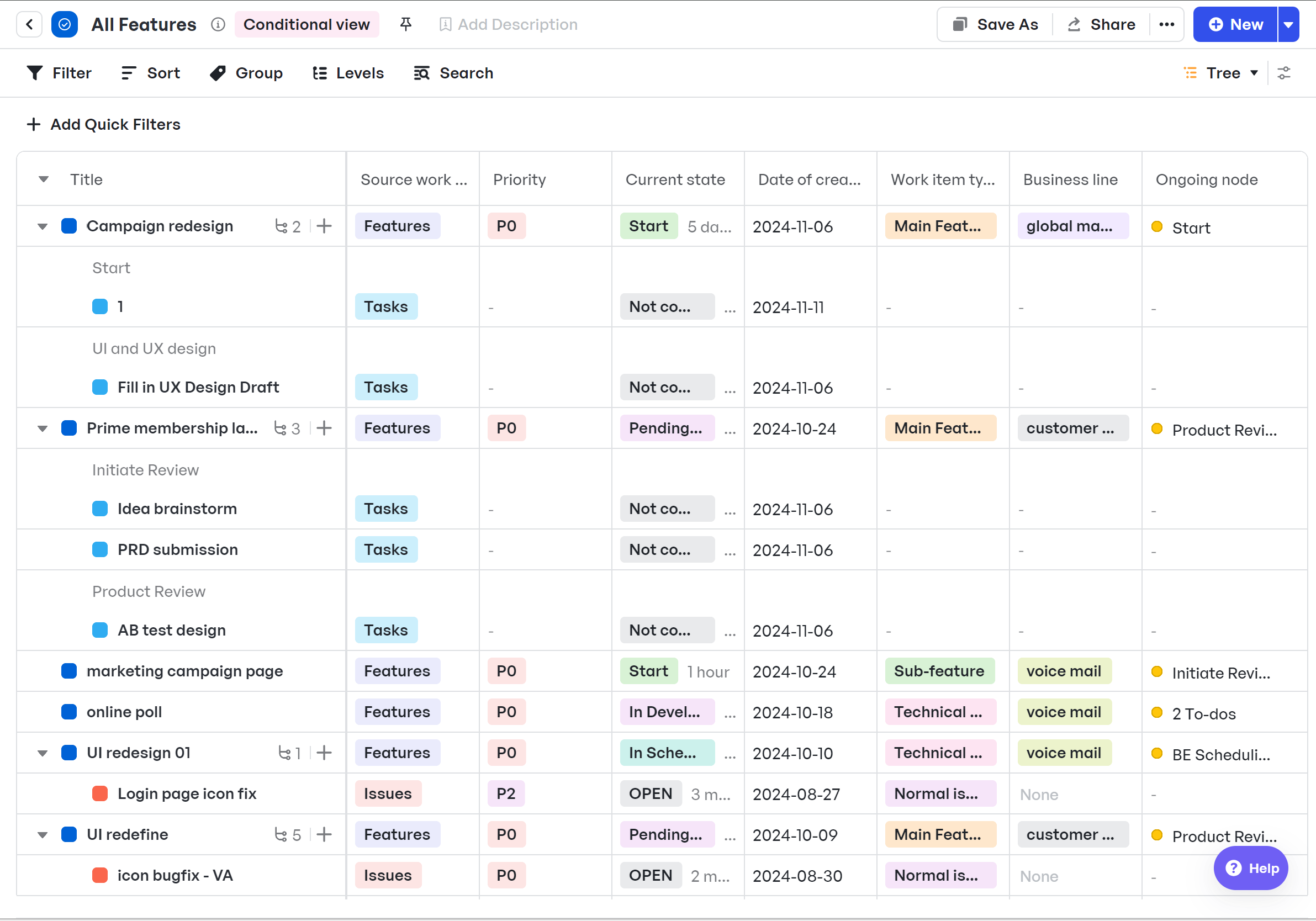
- Kanban View visualizes task flow and progress
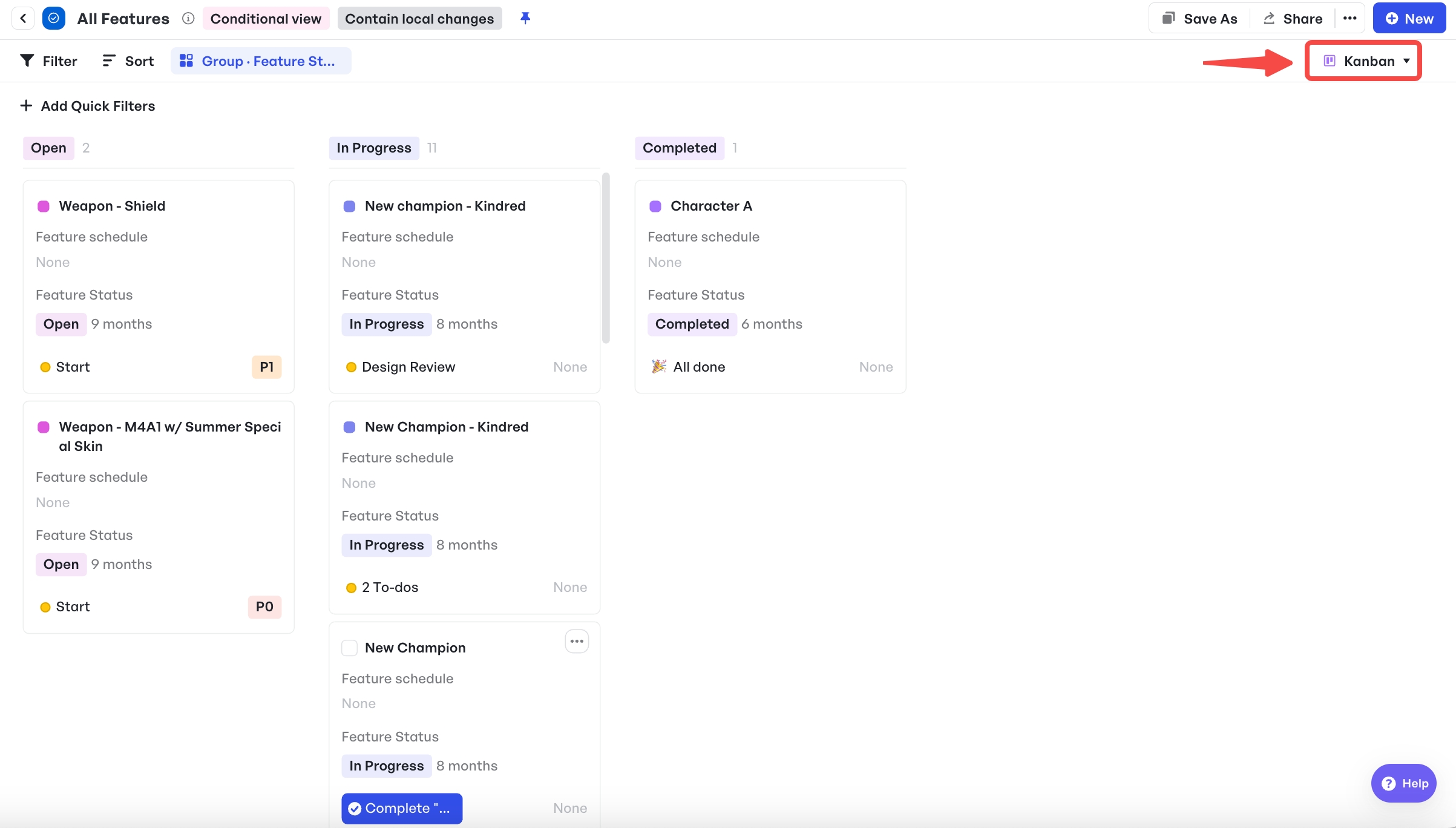
Multiple view flexibility lets you switch between daily, weekly, and monthly perspectives for both detailed planning and high-level strategy. This reduces the need to maintain multiple tools or constantly switch contexts.
Challenge 3: Sales driving the roadmap
Urgent sales requests often override long-term product strategy, pushing product managers to prioritize short-term wins over portfolio goals. This misalignment delays strategic initiatives and risks market competitiveness.
Solution: Structured intake processes evaluate sales requests objectively, balancing customer needs with portfolio priorities. By standardizing how requests enter the roadmap—using criteria like strategic fit or RICE scoring—teams maintain focus on high-impact products.
Meegle solves this challenge for you by:
Prioritizing sales requests
In Meegle, every sales request is submitted through the same workflow. For example, a sales rep fills out a simple form with the request details, and the item appears in a centralized backlog. Because all requests enter one system, nothing is lost in email or chat.
You can immediately see new requests side by side and quickly triage them, scoring or ranking each against existing plans.
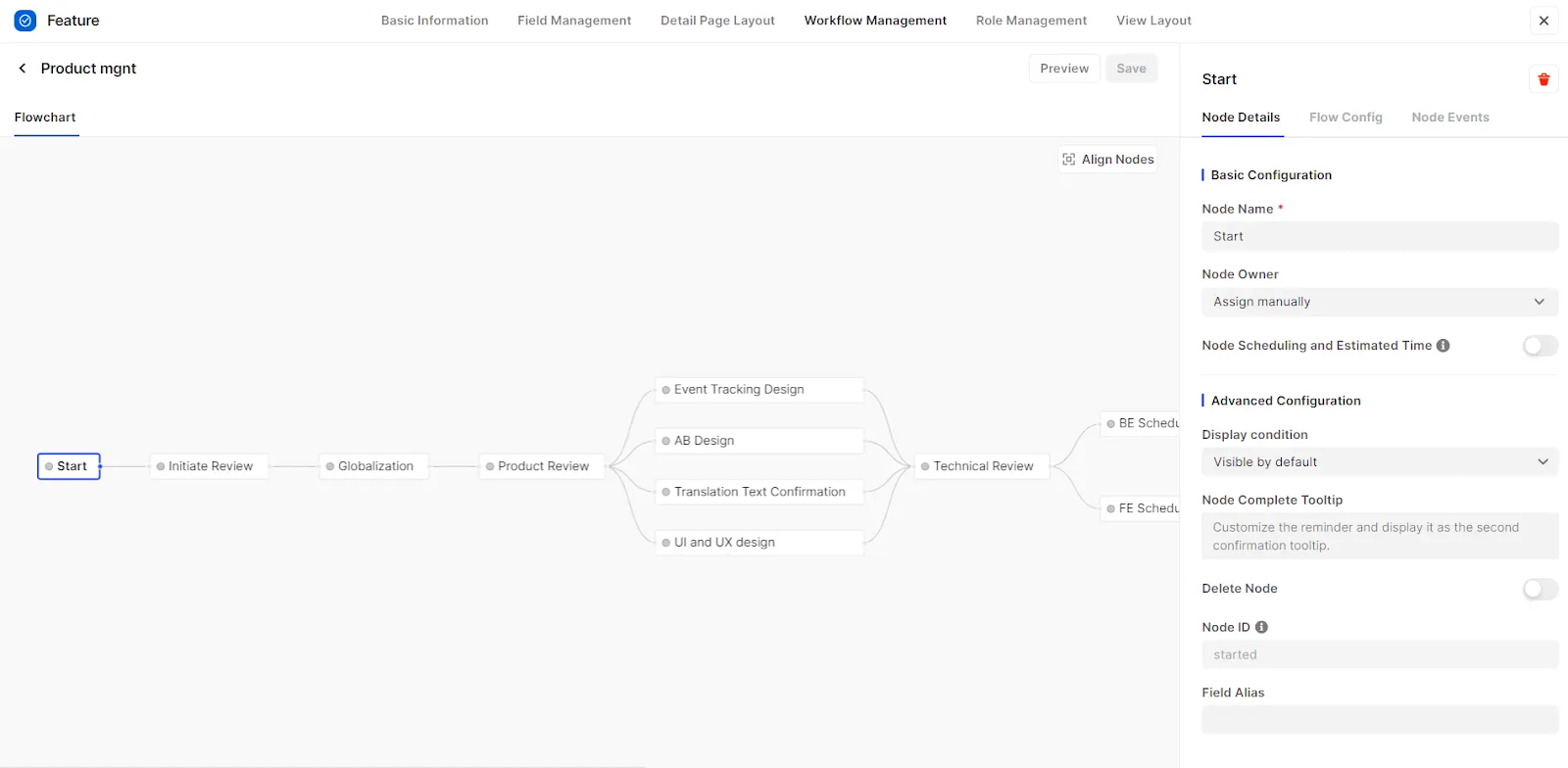 Meegle's workflow management interface shows a flowchart with configurable nodes and node configuration options.
Meegle's workflow management interface shows a flowchart with configurable nodes and node configuration options.Meegle lets you customize the intake workflow with your own scoring fields. You might add fields for strategic priority, estimated revenue impact, or RICE components. The platform can even compute a composite score automatically.
By building scoring criteria into the process, Meegle enforces objective evaluation: requests earn their place on the roadmap based on data, not politics. Teams can configure which factors matter most and adjust them over time as strategy evolves.
These automations also streamline request handling across teams, eliminating status-chasing via email or chat.
Collaboration workspaces
Every request lives in a shared workspace that includes all relevant teams.
When a request advances stages (e.g., from “New” to “Under Review,” or from “Approved” to “Planning”), Meegle automatically notifies the right stakeholders.
For instance, once a request is approved, engineering and finance could receive alerts to start planning and budgeting. All comments, scores, and decisions are logged on the request record, so everyone sees why a request was approved, postponed, or rejected. This transparency keeps product, sales, and other teams aligned.
Through role-based access controls, each department sees only relevant information while maintaining full portfolio visibility.
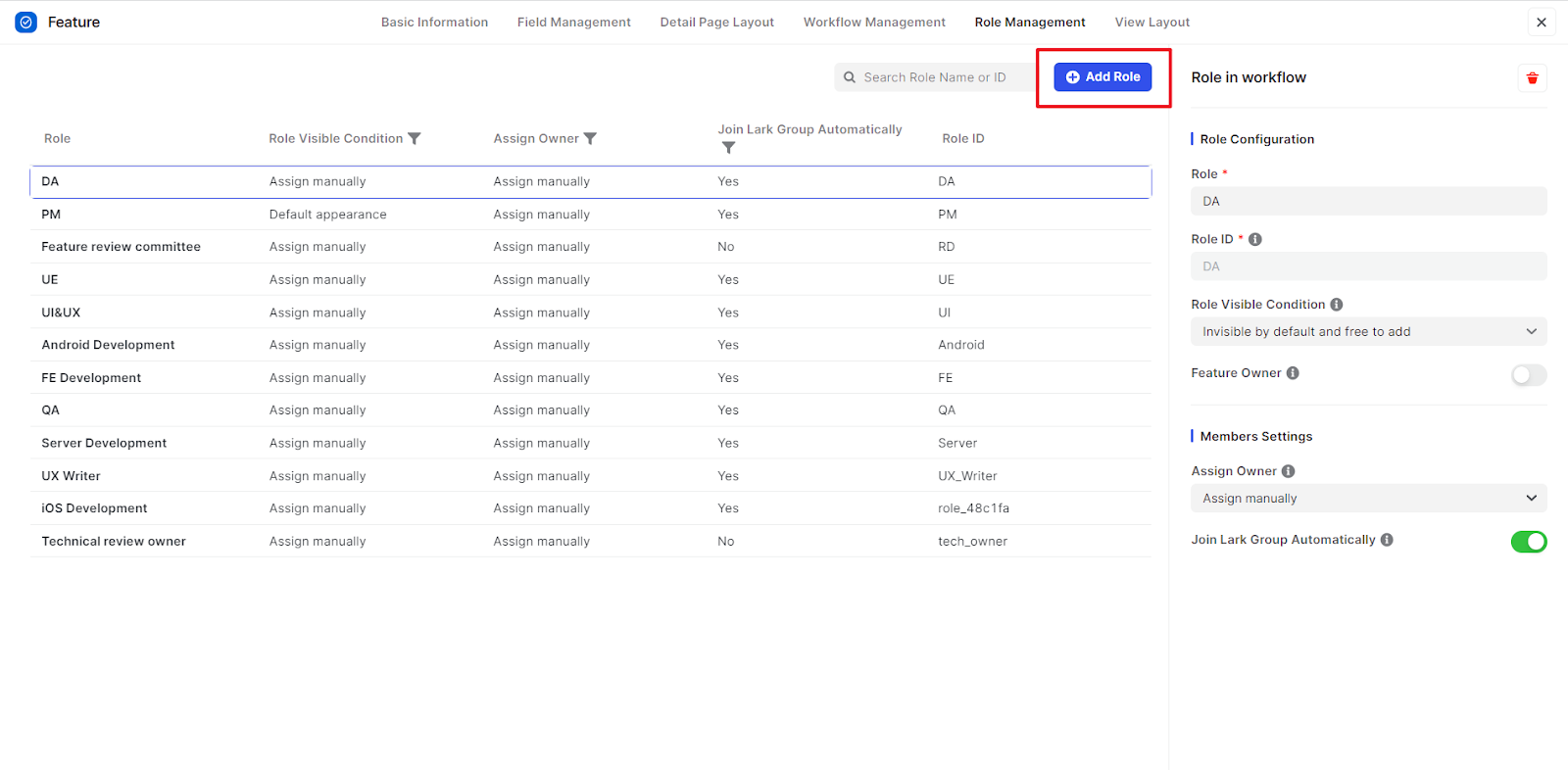
Automated workflows
Automated workflows eliminate manual-status-chasing by triggering updates when budgets shift, deadlines change, or resources get reallocated. Marketing teams receive automatic notifications when products enter beta testing, and product managers can track cross-departmental dependencies without endless email chains.
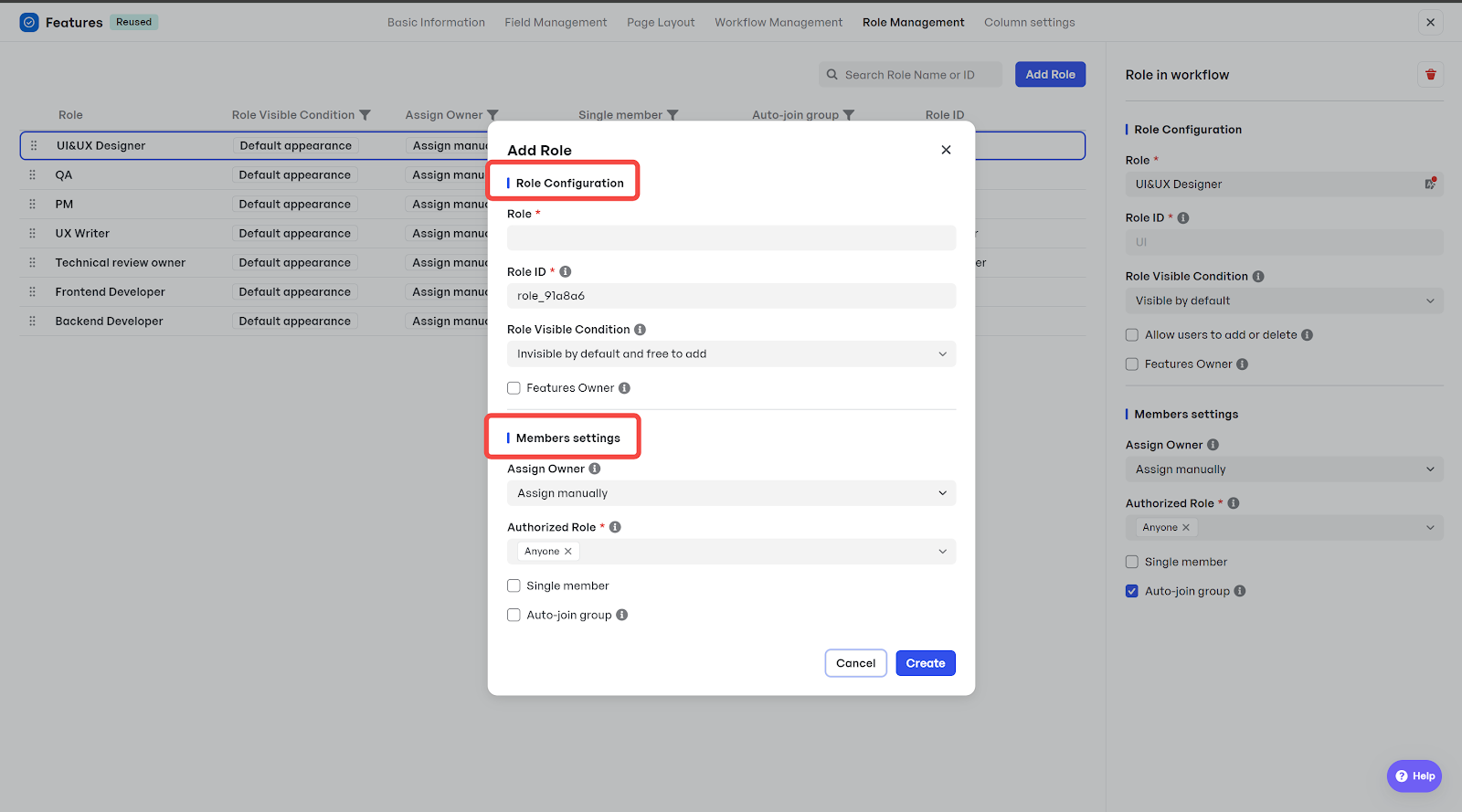
Challenge 4: Portfolio cannibalization
New product launches can unintentionally erode revenue from existing products, disrupting portfolio balance. A new feature release might reduce the appeal of a higher-margin legacy product. Or a newly launched SKU may confuse customers, leading to reduced sales across the board. This kind of internal competition—known as portfolio cannibalization—can undercut profitability and fragment your market position.
Solution: Evaluate product overlaps and market fit before launch to minimize cannibalization. Analyzing target segments, positioning, use cases, and lifecycle stages helps ensure new products complement—rather than compete with—existing ones. Ongoing visibility into market performance also allows teams to adapt quickly if overlap does occur.
Here is how Meegle can help you:
Portfolio interdependency mapping
Meegle’s Program Interdependency Mapping Template visually maps how products relate across your portfolio. It highlights overlaps in features, audiences, or launch timelines—flagging risks of cannibalization before they impact revenue. For example, if a new line extension is targeting the same user base and solves similar problems as an existing offering, the template highlights this early, prompting a deeper review of positioning.
Challenge 5: Sunsetting products
Delays in retiring outdated products drain resources and confuse customers, reducing portfolio efficiency. Teams hesitate due to emotional attachment or unclear data, prolonging unprofitable offerings.
Solution: Apply clear lifecycle criteria, such as declining revenue or low usage, to decide when to sunset products. Structured workflows ensure timely, objective decisions.
Meegle helps in this through:
Product lifecycle management
Meegle’s customizable workflows let teams set criteria, like revenue thresholds, to review product health and streamline sunsetting decisions.
Lifecycle tracking
Meegle’s lifecycle charts track revenue, usage, and customer adoption across products. You can see how new launches are affecting adoption of existing offerings. Is your product portfolio growing consistently, or competing internally?
Customizable charts let each team visualize portfolio health from their perspective—revenue projections for finance, launch timelines for marketing, and technical debt for engineering—all from the same unified data source.
Data-driven insights
Meegle’s charts integrate usage, revenue, and cost data, providing evidence-based insights for confident retirement decisions.
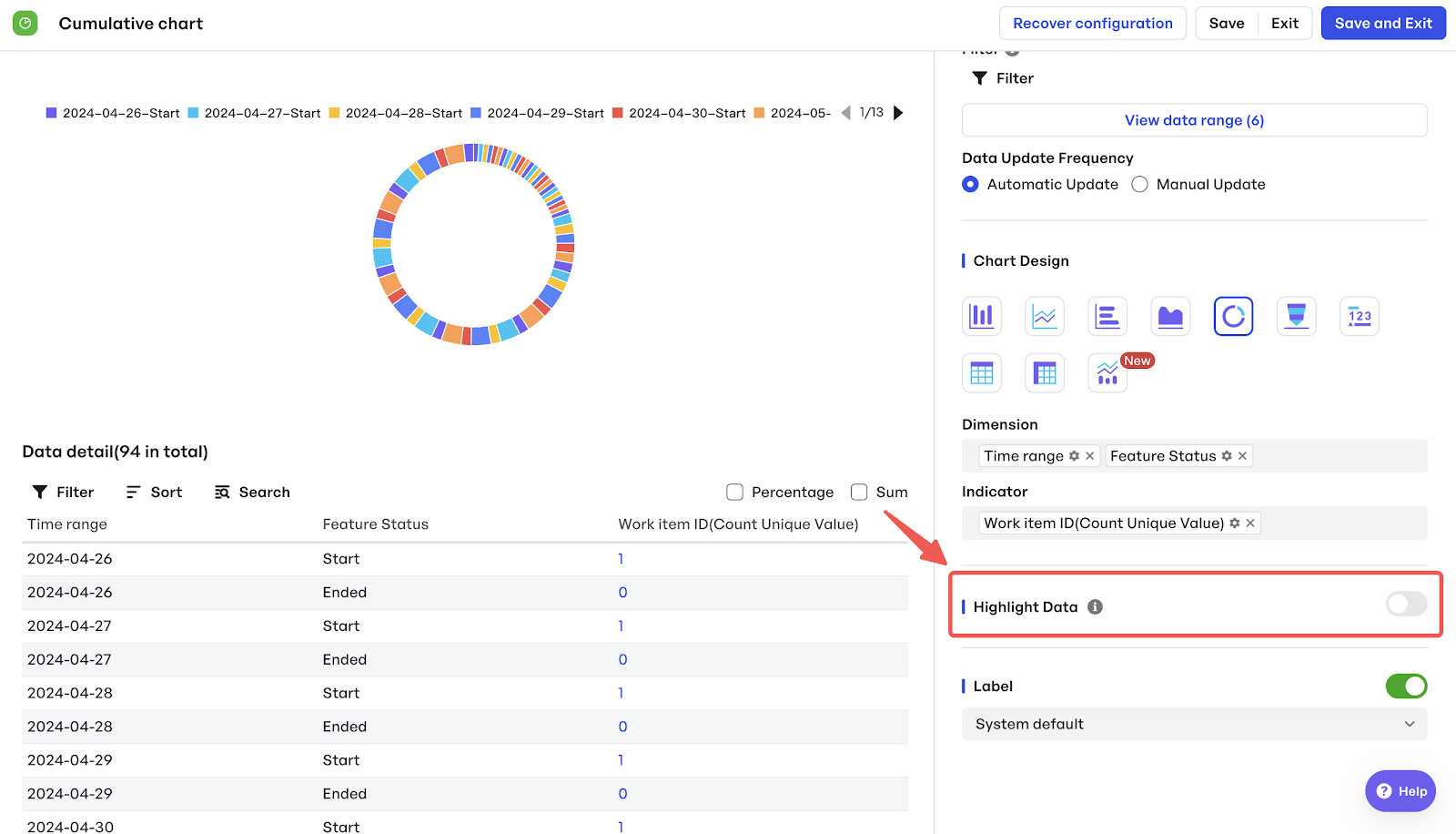 Meegle's chart presents data in visual and table format. The interface includes chart design options and data filtering capabilities.
Meegle's chart presents data in visual and table format. The interface includes chart design options and data filtering capabilities.Unlike rigid portfolio tools, Meegle offers flexibility, fast decision-making, and cross-team visibility without sacrificing control. Whether you're optimizing a few products or managing a complex ecosystem, Meegle helps you stay focused, aligned, and ahead of change.
Support product portfolio management with Meegle’s tools that unify strategy, planning, and execution.
FAQs
1. What are the 4 types of product portfolio management?
The four types of product portfolio management are strategic (aligning with long-term goals), tactical (optimizing short-term execution), growth-focused (prioritizing expansion), and balanced (diversifying risk and reward). Each supports effective portfolio decisions.
2. What is the role of a product portfolio manager?
A product portfolio manager drives product strategy, prioritizes initiatives, allocates resources, and aligns with business goals in product portfolio management. They maximize ROI and ensure market competitiveness through data-driven decisions.
3. What are the 5 main techniques for portfolio management?
Five techniques for product portfolio management: prioritization (e.g., RICE), life cycle analysis, resource allocation, portfolio mapping, and KPI tracking. These methods optimize product performance and strategic alignment across portfolios.
4. What are the benefits of product portfolio management?
Product portfolio management enhances ROI, aligns products with strategy, optimizes resources, and minimizes overlaps. It improves decision-making, reduces waste, and boosts market competitiveness for sustainable business growth.
5. How to use a growth-share matrix for product portfolio management?
In product portfolio management, use the growth-share matrix to categorize products as Stars, Cash Cows, Question Marks, or Dogs by market growth and share. Prioritize investments to balance growth and profitability.
The world’s #1 visualized project management tool
Powered by the next gen visual workflow engineRead More
Check All BlogsStart creating impactful work today
